Constable Ronald Pitt
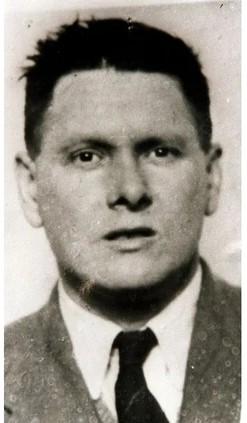
While the story of Constable Ronald Pitt was mostly based in Morrisburg, his story was strewn over newspapers all across Canada. For a moment in time Dundas County was front and centre in the headlines across the country. His was a story of tragedy, the murder of a police officer alone at night by two unknown car thieves. No one was ever charged with the murder. His file remains open and is still unsolved today.
34-year-old Ronald Pitt arrived in Dundas County in June 1957 from his native Glasgow, Scotland. He was in search of a career opportunity and a better life for his family. His wife Margaret and his two sons, Ronald Junior aged 7 and Ian aged 3 would remain in Scotland for a few months until he had found a job and settled in. He had formerly served in the Glasgow police force as well as having served in the British Army for four years. According to his wife, he dreamed of being a police officer. So, when the Morrisburg Municipal Police Force advertised for a role as Constable he applied. Morrisburg was a busy community in 1957, with the construction of the St Lawrence Seaway happening at the time. It was bustling with workers from all over, and at times could be a rough patch in the afterhours.
Constable Ron Pitt had been living in a house with fellow Constable Peter Burton and had undergone some of his proposed training. He had not yet been issued his full uniform when he was asked by Peter Burton to trade shifts as Peter had a date on the evening of August 24. Ron did take on the shift and most of the night was relatively quiet until he noticed a couple of hooligans stealing a car. He made chase in the cruiser until they abandoned their pickup truck in front of the home owned by Betty and Parker Locke. The thieves ran behind a hedge and Constable Pitt exited the cruiser to speak with the two men. They emptied their revolvers, two bullets hit Pitt’s chest, and one hit his finger. The thieves took off in the cruiser. They abandoned the car north of Iroquois and were never seen again.
As Constable Pitt lay in a pool of blood, the Lockes tried to call the Morrisburg Police office but since it was 5 am no one answered. Harry Ing, who worked in an all-night diner nearby called the OPP attachment in Cornwall and they sent a police officer. Many people made comments later that the situation might have ended differently if the cruiser that Pitt drove had a two-way radio installed or if two constables were on duty at the time.
The first bullet passed through Constable Pitt’s chest and exited. The second bullet was lodged in his spine and as a result he was paralyzed from the waist down. He had lost consciousness when help finally arrived. Local pharmacist, Mac Johnson, arrived on the scene at about the same time, having been awakened by the shots. He was rushed to hospital in Cornwall and needed a blood transfusion. Eight Police officers immediately donated blood. When word got out in town the community rallied and carloads of citizens arrived at the hospital to donate blood. It was apparent however that he needed to be transferred to a trauma hospital. The RCAF helicopter from Rockcliffe Air Force Base was summoned and air lifted him to Montreal along with his friend Constable Peter Burton. Burton stayed with him until his wife arrived from Scotland.
While Margaret and the children had planned to move to Morrisburg to join Ron, their journey was moved forward due to the shooting. A fund was created by local citizens to bring the family to Canada. They arrived in Montreal on September 6, on the Polish liner, “Batory”. The Red Cross provided them with an apartment in Montreal and a home in Morrisburg. The Citizens of Morrisburg contributed $3,000 to a fund for the care of the children, this was a sizable amount in 1957. The fund was facilitated by then Reeve George Beavers.
Despite great hope of a recovery, Constable Ron Pitt died of his injuries, losing the battle in the early hours of September 23, 1957. He was allegedly buried in his new uniform in Maraitown. The funeral was held at the Morrisburg United Church. According to various newspaper reports, Pitt’s dying wish was for his wife and children to stay in Canada. Reports from the Workman’s compensation Board indicated that she would receive a police widow’s pension. There were no further reports on the family after this. In 2015, the 750 Highway 401 overpass at Morrisburg was named the Constable Pitt Memorial Bridge, in his memory. His son Ronald Junior attended from the UK, so they did return to Scotland. His younger brother had died at age 17.
No one was ever charged with the murder of Ronald Pitt. The case was re-investigated in 2002, by Detectives Morgan Hill and John Ralko and remains an open file. While the trail ran cold very quickly, this case is still open with the OPP. After his death recommendations were made for constables to patrol with a partner at night, and radios were to be installed in cruisers. Pitt is named on the Canadian Police and Peace Officer’s Memorial as well as the Ontario Provincial Police Association Honour Roll.
Susan Peters
Dundas County Archives, Archivist

Sources:
Saturday August 24, 1957
The Montreal Star, page 1”Wounded constable brought here”
The Owen Sound Sun Times page 1 “Pair at Morrisburg flee in police car after gun battle”
The Daily Nugget (North Bay) page 1 “shoot Officer, Flee in cruiser”
St Catharines Standard (St Catherines ) page 1 “officer shot while probing theft of car”
Times Colonist (Victoria B.C.) page 9 “Constable felled by bandits gun – fights for life”
The Windsor Daily Star page 1 “Gun battle fells police rookie”
Monday August 26, 1957
Kitchener – Waterloo Record, page 3 “Constable shot by thugs still critical”
The Hamilton Spectator, page 2 “Wife of wounded policeman hopes he can return to post”
Windsor Star page 6 “Copter Flight aids felled Copper”
Brantford Expositor page 1 “wounded policeman remains in critical condition in hospital”
Monday August 27, 1857
The Owen Sound Sun – Times, page 1 “Kind-hearted citizens fly wife to bedside of Morrisburg Constable”
Thursday August 29, 1957
The Chesterville Record, page 1 “Ronald Pitt Fund”
Friday August 30, 1957
The Kingston Whig Standard, page 8, “Pitt to get Workmen’s payments”
September 3, 1957
Nanaimo Daily News, p 3 “Give blood”
Thursday September 5, 1957
The Ottawa Citizen, page 18 “Talks to him – wounded constable’s wife lands in Canada”
Friday September 6, 1957
The Ottawa Journal, “Mrs. Pitt sees husband in hospital”
The Ottawa Citizen, “Family reunion best tonic to aid wounded constable”
Kitchener – Waterloo Record, page 4 “Wounded Policeman’s family reach Quebec”
The Montreal Star, page 27, “wounded police officer and family are united in Montreal hospital”
Saturday September 7, 1957
The Montreal Gazette, page 21, “ Fortune smiles on Pitts in mute hospital reunion
Brantford Expositor, page 3 “Wounded policeman united with family”
Wednesday September 18, 1957
The Ottawa Citizen, page 7 “Constable near death”
Monday September 23, 1957
The Owen Sound Sun-Times, page 1 “Constable dies”
The Ottawa Citizen, page 1 “police rookie is dead”
Edmonton Journal, page 16 “Policeman dies of gun wounds”
Kitchener-Waterloo Record, page 1 “Constable dies of gun wounds”
Tuesday September 24, 1957
The Albertan (Calgary), page 8 “ Officers dies of wounds”
The Ottawa Citizen, page 6 “Constable Ronald Pitt” and page 48 “Plea for better police equipment as Morrisburg mourns constable”
Regina Leader Post, page 29 “Constable’s dying wish for wife and children”
The Gazette (Montreal), page 21, “ Mrs Pitt, children to stay here, constable’s dying wish to his wife”
Thursday September 26, 1957
The Ottawa Citizen, page 48 “Plea for better police equipment as Morrisburg mourns constable”
The Ottawa Citizen, page 1 “Police Funeral”
The Chesterville Record, page 1 “Constable Pitt of Morrisburg dies of his wounds in Montreal Hospital”
The Iroquois Post and Matilda Advocate, page 1 “Constable Ronald Pitt loses struggle for life”
Friday September 27, 1957
The Niagara Falls Evening Review, page 11 “Dead officer’s widow will get pension, other benefits”
The Regina Leader Post, page 23 “Constable’s widow gets $75 pension”
The Ottawa Journal, page 25 “Award pension to Pitt’s widow”
Saturday October 5, 1957
The Sault Daily Star (Sault St Marie), page 6 “Tragic case of Constable Pitt”
Wednesday October 2, 2002
The Chesterville Record, pages 1 – 2 “Fallen officer remembered”
April 23, 2014
Morrisburg Leader, “Dedication for Officer Ronald Pitt in the works”
November 18, 2015
Morrisburg Leader, “Cst Ronald Pitt Memorial bridge dedication in
September 28, 2019
Ottawa Citizen, “Officer down: the fallen remembered.”
Ontario Provincial Police Association https:/oppa.ca/
Honour Roll of OPPA (https://oppa.ca/about-oppa/honour-roll/)
Ontario Police Memorial Foundation
https://www.opmf.ca/control.php?officer_id=113
Memorial for Constable Ronald Pitt
Previous Articles
- Image
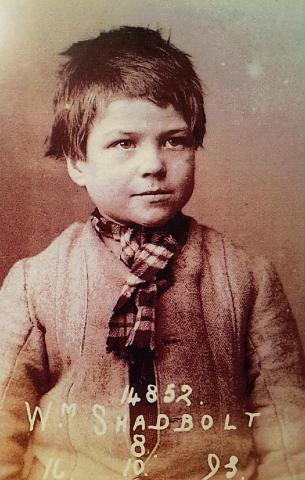
The British Home Children of North Dundas
On September 28, people across Canada commemorated British Home Child Day. But who were the British Home Children?
In 1869, religious and philanthropic organizations in Britain began to send orphan and pauper children to Canada to give them a chance at a better life. Young children were to be adopted, and older children were to be indentured as domestic servants and farm labourers until they turned 18.
The emigration program operated until 1948, by which time over 100,000 children had been sent to Canada. While some found loving homes and fair employers, others suffered severe abuse and trauma.
Over 10% of Canadians are descended from Home Children. However, the stigma attached to these children led many to hide their pasts, meaning that descendants are often unaware of their family history.
British Home Child Day is an opportunity to recognize this history. It was first observed in Ontario in 2011 after a bill tabled by former Stormont-Dundas-South Glengarry MPP Jim Brownell was passed in the Ontario Legislature.
Brownell, a Home Child descendant, chose September 28 to commemorate the day that his grandmother arrived in Canada.
The late Judy Neville, Brownell’s sister, spearheaded the effort for a federal British Home Child Day. She and others worked with the office of former SDSG MP Guy Lauzon to put forth a motion in the House of Commons, which passed in 2018.
More than 300 British Home Children came to North Dundas, both as indentured children and as adults. Some were here for a short time, while others remained in the district for the rest of their lives. Regardless, they left their mark on this community and their legacy endures through their contributions and those of their descendants.Written by Ashley Harper
Chesterville and District Historical Society - Image
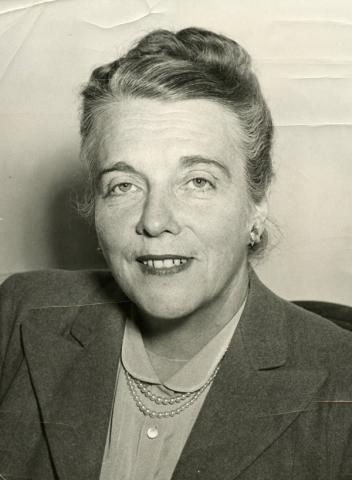
Dr. Marion Hilliard (1902–1958)
Hero of women in Dundas CountyDr. Marion Hilliard was born and raised in Dundas County, but her impact was felt nationwide.
In fact, she impacted the lives of women throughout the world. And yet, not that many people are aware of her or her place in Dundas County history.
As one of the first female gynecologists to be licensed in Canada, she earned her place in our history books. She was part of the team that developed clinical testing for women’s cancers. She also helped to promote women’s health initiatives through her clinic in Toronto and her series of articles for women (and men) published in Chatelaine Magazine between 1954 and 1957. She certainly paved the way for women’s health.
In these articles she wrote about topics that were simply not discussed in polite society at the time. They embraced topics such as female sexuality, menopause, postpartum depression and parental fatigue. She was early to point out that a medical doctor’s role was to be a sociologist as many ailments are rooted not in the physical but in mental and emotional causes.
Her articles in popular press were important as she realized how little most women knew at the time about their own health. Her articles were then combined into several books and translated into many languages and available worldwide.
Dr. Marion Hilliard also played a role in the development of the PAP test, to detect cervical cancer. The procedure was first developed by George Papanicolaou in the 1920s, but Hilliard and a team of other doctors developed a more simplified form of the test in 1947. It was for this accomplishment that in 2018 she was nominated to appear on the new $10 bill, but Viola Desmond was selected instead.
She was also extraordinarily successful in her drive to make the Women’s College Hospital an accredited teaching hospital under the University of Toronto Medical School. She eventually became the head of the Obstetrics and Gynaecology Department in 1947, a position she held until retiring in 1957.
Unfortunately, she did not enjoy a long retirement as she died of cancer in 1958. She was buried in her hometown of Morrisburg.
It is my hope that people will remember Dr. Marion Hilliard for her selfless dedication to women’s health. It was a personal goal of mine to nominate her to the Canadian Medical Hall of Fame. Their mission is to honour medical heroes – those of the past, present and future. In their description, a medical hero is one whose work has advanced health and inspires the pursuit of careers in health sciences. That certainly describes Dr. Marion Hilliard.
However, she was not one of the people selected for this honour. Dr. Marion Hilliard is my hero and the hero to the women of Dundas County and those who have loved them.Written by Susan Peters
Dundas County Archives
dundascountyarchives@gmail.com - Image
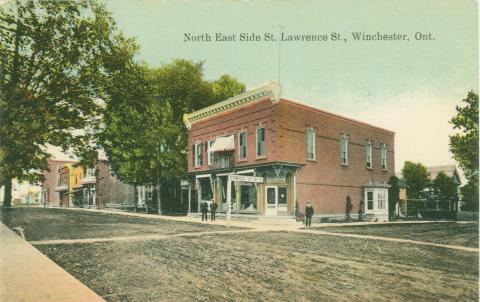
William Bow (1825 – 1915)
Longest serving postmaster in Dundas CountyWilliam Bow was born on May 18, 1825 in Aberdeen, Scotland to Thomas Bow and Mary Jack. He immigrated to Canada around 1840 and settled in Mountain Township, where he farmed for a number of years.
In 1846, he married Charlotte Fleming and the couple had four children: Thomas, Emily, George and Margaret.
He gave up farming in 1848 to become a schoolteacher, spending five years at Cass Bridge. He and his family then moved to West Winchester, where he taught for two more years before opening a grocery store, then a general mercantile business.
When a post office was established in the village in February of 1855, William was appointed postmaster—a position that he would hold for the next 57 years. It originally operated out of his general store on the north-west corner of Main and Ottawa Streets.
Winchester became an incorporated village in 1888, and later that year the post office was moved to William’s newly built store on the north-east corner of St. Lawrence and Caleb Streets (now Mary’s Restaurant).
William continued as postmaster until December 1912, when he was relieved of his duties at age 87. To date, he is the longest serving postmaster in the history of Dundas County.
William was involved in all aspects of the community. He served as Winchester’s police magistrate for over 30 years and became known as a strict but fair enforcer of the law, especially during the years of local option when the sale of alcohol was prohibited. He was also the superintendent of the Methodist Sunday school for several decades.
In addition to the post office, he owned several businesses during his career. He operated his general store until 1879, when he passed it on to his son George and son-in-law Alex Ross in favour of becoming a druggist.
By 1910, the druggist business had been taken over by his grandson George H. Challies (future MPP for Grenville-Dundas) and William had moved on to selling stationery and fancy goods.
William Bow passed away on April 2, 1915, just one month before his 90th birthday. He was laid to rest beside his wife at Maple Ridge Cemetery.
His dedication to the village and its people made him a much loved and respected man, and the loss of Winchester’s ‘grand old man’ was keenly felt throughout the community.Written by Ashley Harper
Chesterville and District Historical Society - Image
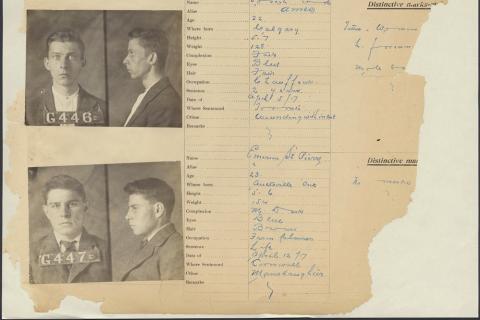
Helping to solve a historic murder
A day in the life of an archivistI’m often asked about what happens on a daily basis at the archives. The answer is that it depends on the day. Every day can be a new adventure.
Some are spent searching for building permits or drain records, others I catalogue boxes of By-laws and Minutes of Council. One day I might search through newspapers for someone on the phone, including the odd professor wanting to settle a bet with a colleague.
As an archivist, I collect, preserve and make available the records of the region.
I have visited a farm house where coroner investigation records were found in a sealed envelope between walls of the home. How they ended up there is anyone’s guess.
The Dundas County Archives has only been around for a few years and a major focus has been put on historic newspapers. We have brought in the entire collection of the back issues of the Winchester Press and Chesterville Record.
Through generous individuals, we have received donations of Iroquois Post, Iroquois Chieftain, the St. Lawrence news, Morrisburg Banner and several other publications.
This is all part of a huge project to collect and digitize the historic newspapers of the county, in partnership with the Lost Villages Historical Society and the Glengarry County Archives, through generous donations from local service clubs and funds from the United Counties Council.
What is truly remarkable is that these are accessible to the public free of charge.
This has been a huge undertaking because in many cases, the old papers are in pretty bad shape. They are brittle, fragile and in many cases ripped or fragmented. Before they can be scanned and digitized, they must be repaired to archival standard. One can get a little bleary-eyed with all this piecing together, like a long-forgotten puzzle with no visual guide.
Some days I self-identify as a newspaper whisperer.
But back to what happens at the archives on any given day. I was asked recently if I could help the police in an investigation of a possible historic homicide, believed to have taken place in 1925.
There was a tip that an individual may have been murdered and his body buried in the basement of a rural home. My job was to look through records and try to identify where the house was located. I also searched for death records because odds were that a story like was reported on.
The challenge is that due to the fragile nature of newspapers, not all periods are covered by the existing collection. Fires, rodents and other issues have caused many of these back issues to be destroyed over time.
Luckily, we did have copies of the Chesterville Record and Morrisburg Leader from that period. After a thorough examination, I determined that this murder did indeed occur.
On February 8, 1917 William St Pierre was murdered. His body was hidden in the basement of his home and the case was covered by local newspapers, along with publications all across Canada and the United States. Initially the suspect was 17-year-old Nettie Richmire of Williamsburg. Eventually it was determined that her confession was intended to protect her boyfriend, Emerson St Pierre, the son of the victim.
The investigation was covered by newspapers as far away as Saskatoon and Vancouver and the further afoot, the more sensational the story. By March 12, American papers reported that St Pierre had murdered as many as 20 infants, allegedly all of whom he had fathered.
The South Bend Tribune in Indiana said that these 20 infants were all born to St Pierre’s widow and that he had murdered mostly male infants.
The St Louis Star in Missouri reported that Mrs. St Pierre stumbled on her late husband’s grave in their basement while collecting coal for the fire, after he had been missing for three weeks. It also said that her son Emerson was arrested while on route to Syracuse, New York with a large sum of money.
The coroner’s inquest began on March 13 with at least 600 people in attendance, many of whom were reporters. Apparently, people were injured in the rush to get access to the inquest.
The reports of the case were highly variable, but most attested that Nettie was sexually assaulted by William - more than once - and she acted in response to her concern for her own safety.
She was given a more lenient sentence of 5 years in prison. Emerson was convicted of manslaughter and served a life sentence at the Kingston Penitentiary.
But their story doesn’t end there. They did eventually get married after Emerson served his sentence and they lived out the rest of their lives together in Dundas County.
As for what happens next at the archives, only time will tell. Every day is a new adventure.Written by Susan Peters
Dundas County Archives
dundascountyarchives@gmail.com - Image
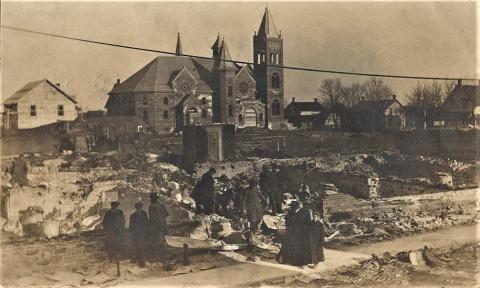
Chesterville King Street Fire, 1909
In the early hours of April 6, 1909, Chesterville residents were awoken to the alarm of fire and the smell of smoke. Within hours, an entire block of the village’s business core was reduced to rubble. It would become known as the worst conflagration in the history of Chesterville.
It originated in a wooden-framed building on the north-east corner of King and Water Streets, which housed W. J. Nash’s tailor shop on the first floor and the Masonic Hall on the second. The flames quickly spread east down Water Street to the Chesterville Record office, destroying the printing presses, then travelled north up King to Ralph Street.
Equipped with only one hand pump and pails for water, there was very little that could be done. The fire destroyed everything in its path, including Wilford Saucier’s jewellery store, Isaac Pelletier’s confectionary and fruit store, Gordon Robinson’s blacksmith shop, Joseph Fisher and Colborne Robinson’s butcher shop and the Sanders, Soule and Casselman general store.
The village was left rattled by this tragedy - it was not the first they had dealt with that spring. Exactly three weeks before this incident, the Temperance Hotel and Foster’s Hall, situated at the north end of King Street, burned to the ground, and the train station and water tower narrowly escaped with minor damage.
In light of these incidents, steps were quickly taken to improve the village’s fire protection. By May, the village council was preparing a new by-law to mandate that only ‘fireproof’ (e. g. brick, stone) buildings could be erected in the business section. That summer, a steam pumper fire engine was purchased and a proper fire department was formed with Frank McCloskey as fire chief.
Meanwhile, life went on in the village. The Chesterville Record was back in print on May 6, operating from a temporary office in a blacksmith shop. By the end of the summer, bigger and better buildings replaced those that were lost. Sanders, Soule & Casselman rebuilt on their former site (now Mike Dean’s). The Fisher Block (burned in 1989, now the Mike Dean’s parking lot) was erected, where Fisher and Pelletier carried on their businesses. The new Record building (demolished in 2018) was constructed and Saucier rented part of the space for his jewellery store. Wesley Hamilton built the Hamilton Block on the corner of King and Water Streets (now Louis’ Restaurant).
The response to the King Street fire demonstrates the resilience of this village and its people - something that we continue to see today.Written by Ashley Harper
Chesterville and District Historical Society - Image
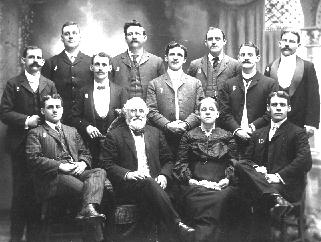
The furniture makers of Dundas County
Dundas County was originally settled in 1784 by loyalist refugees of the American Revolution. As refugees, they brought with them only basic necessities for their new life in the wilderness. While they did have furnished homes in the Colonies, their loyalist leanings necessitated their departure and all their worldly goods were confiscated by the Americans. As they resettled into what became Dundas County, they had to start fresh.
It was not until 1847, with the completion of the St Lawrence Canal, that industry could build. Iroquois was the industrial center of Matilda Township, as Morrisburg was for Williamsburg Township. The Williamsburg Canal enabled the harnessing of water power so that mills could be built in Morrisburg, along with the construction of the Grand Trunk Railway in 1854. It was not until 1884 that Mountain and Winchester townships were serviced by rail courtesy the Canadian Pacific.
As industrialization was slow in Dundas County, so was the development of furniture making. For many years, rural settlers could only afford the absolute bare necessities for survival. The first furniture makers did not advertise in local newspapers until 1842.
The first known cabinet maker in Dundas County was William Marsh. His son continued with the business until at least 1900. They were listed in directories, census and newspaper ads in Iroquois. By 1884, his son W.J. March was also listed in an advertisement as ‘furniture maker and undertaker.’
Between 1840 and 1900, there were 112 cabinet or furniture makers in Dundas County.
Several were long-term businesses, such as M. F. Beach. Nearly two-thirds were located in Iroquois. Other communities have supported furniture makers, including Pleasant Valley, New Ross, Glen Stewart, Brinston and Dundela.
As Mountain Township did not have water access, it was slower to develop industries. Mountain was home to 13 per cent of the furniture makers of the county. Two were in Inkerman, three in South Mountain and two in Van Camp.
Elijah Gregory was in business in South Mountain from 1874 to 1900. Earnest Hunter served the same region from 1896 to 1900. Inkerman was the base for William Suffel from 1864 to 1871. George Hope served Van Camp from 1881 to 1895. His business included a general store as well as furniture and he was succeeded by his son Wesley in 1881.
Williamsburg produced 32 cabinet makers between 1842 and 1900. About half of these were short lived. Twenty-one lived in Morrisburg and two in East Williamsburg. Five were in North Williamsburg. Brothers John and William Kilgour ran their business out of Morrisburg from 1873 to 1900. In 1895, they began manufacturing coffins as well.
They were only surpassed by Mahlon Beach of Winchester and Iroquois. In 1865, the Morrisburg Cabinet factory was established by E. W. Kellogg. He produced chairs, bedsteads cabinets and ‘other furniture.’ By 1871, they were also building coffins.
Winchester Township was a challenge to research due to the fact that a large percentage of the furniture makers had a very short tenure. The other challenge was the constant name changes of the communities.
Armstrong Mills became known as Winchester in 1845. In 1875, it was changed to Chesterville. Bates Corners was at one point known as West Winchester. By 1892, it was known as Winchester Village.
The township produced 33 of the 112 cabinet makers in the County.
In West Winchester (later known as Winchester Village), John Ross operated as a furniture maker and undertaker from 1890 to 1896.
The most noteworthy of cabinet makers in Dundas County was Mahlon Beach. He moved to Winchester in 1856 and set up a saw mill. Between 1861 and 1878, he also operated a general store, cheese factory and a grist mill. In 1883, he ran a roller mill in Iroquois.
On July 12, 1884, the entire plant in Winchester was destroyed by fire. But he was undaunted and built a bigger factory. He was by far the largest player in the furniture business, employing over 100 people in 1900. His success could partially be attributed to a long-term contract with the Eaton’s Company during this time: selling ready-made furniture through their show rooms and catalogue.
Beach was also involved in local politics. He was Warden of SD&G Counties in 1873. He left a legacy with 10 children, many of whom continued in his business endeavours.Written by Susan Peters
Dundas County Archives
dundascountyarchives@gmail.com - Image
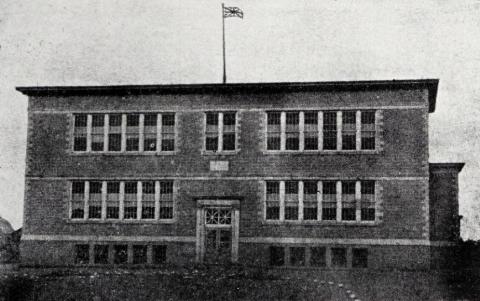
North Mountain Consolidated School in Hallville
The first and only of its kind in Dundas County historyThis year marks one century since construction began on the North Mountain Consolidated School in Hallville. On August 8, 1922, four hundred people gathered to witness the school’s cornerstone being laid at the southwest corner of County Road 43 and Shaw Road.
Founding a consolidated school, which would accommodate students from kindergarten to Grade 13, was an ambitious plan for this little community. At the time, the school was said to be only the second of its kind in Eastern Ontario, and it remains the first and only consolidated school in the history of Dundas County.
It began in 1921 when residents of Hallville discussed the need for an advanced education facility in the area. The first meeting of trustees was held at St. Andrew’s Church on October 28th, 1921. Soon it was decided to amalgamate four nearby schoolhouses: SS No. 9 Hyndman, SS No. 12 Loughlin, SS No. 13 Kerr’s Ridge, and SS No. 14 Reid’s Mills.
The North Mountain Consolidated School was officially opened on September 19, 1923. Over 150 students were enrolled, and the first staff consisted of principal Orville E. Ault and six teachers: Misses Morrow, Smith, Bates, Pack, Bradley and Millar.
The school was a source of pride for the community but falling enrollment over the years threatened its survival. In 1960, all secondary students were transferred to South Mountain Continuation School, which became known as Mountain District High School. The consolidated school became Hallville Public School.
The same issue of low enrollment caused both schools to close just ten years later in June 1970. While secondary students were split primarily between Seaway High School and North Dundas District High School, elementary students got a new facility: Nationview Public School. The old buildings were temporarily revived during the 1970/71 school year when the construction of Nationview was delayed.
To mark the end of an era, a giant reunion for students of the two schools was held in the summer of 1970 with about 1,200 people in attendance. Another was held in 1995 and a third was planned for 2020, which would have marked the 50th anniversary of the closing. However, it was postponed due to COVID-19.
Unfortunately, the school no longer exists. In the early hours of February 15, 1979, fire ripped through the structure and firefighters could do nothing but watch as it was engulfed by flames. Herbert Scarf, who purchased it in 1973 and had been living there while renovating the building, was away at the time of the blaze.
On 11 October 1980, the crumbling, burnt-out shell of the once bustling school was demolished. Now, all that remains of the North Mountain Consolidated School are memories and photographs.Written by Ashley Harper
Chesterville and District Historical Society - Image

Aaron Sweet (1854 – 1937)
It is often stated that the level of respect for a person can be measured by how many people attended their funeral.
In 1937, when Aaron Sweet died, his funeral had one of the largest attendances in Winchester history. He certainly touched many lives. He was viewed by many as ‘a man apart and unusual in many respects, popular, capable and willing to an unusual degree…and to be without pretense or sham.’
Aaron Sweet was driven and very involved in the community. He was an active member of the Masonic Lodge. At least 300 members of various Masonic lodges attended his funeral at the Winchester United Church, illustrating how respected he was amongst the Masons. The event was also attended by respected church dignitaries.
Who was Aaron Sweet and how did he achieve this level of honour and respect?
He was born in Hemingford Quebec on February 12, 1854, but his family moved to Morrisburg when he was young. Why Morrisburg? It likely had something to do with the fact that his mother was the sister of Andrew Broder. If his name seems familiar it is because Broder had represented Dundas County in the Provincial Legislature from 1875 to 1886, and the Federal Parliament from 1896 to 1917.
The Broder/Sweet clan appeared to be close knit and Aaron was taken under the wing of his famous uncle. Aaron worked in his uncle’s general mercantile store in Winchester in his youth and by 1876, Sweet had become a partner. By 1881 the store was renamed ‘A Sweet and Company,’ so it appears that he became the owner.
Uncle Andrew had taught his nephew a little about community engagement and involvement. In 1876, Aaron was elected as the deputy Reeve of Winchester, while his uncle was serving in the Provincial Legislature. Sweet was later elected as the first Reeve in the newly incorporated Village of Winchester. He also served as a Councillor.
But his involvement in the community didn’t stop there. Aaron was an elder in the United Church, served as Treasurer for the Winchester Public Library, became a Director of the Beach Foundry, as well as the Winchester Arena Company.
The Dundas County Archives recently acquired the first ledger for this company. He was also very active with the Masonic Lodge, the Orange Order, the Agricultural and Horticultural Societies, the Canadian Club and various other organizations.
In his political leanings he was a Conservative. Aaron successfully ran in the 1923 provincial election as a candidate supporting Prohibition. He certainly wouldn’t have supported the move to create Ontario Government ownership of the Beer Store or LCBO. It was during the Prohibition era that Sweet was involved with the establishment of a Temperance Hotel in Winchester.
It appears that his wife, Mary Esther Boyd, was just as driven and community oriented as Aaron. Her commitment and generosity earned Mary the respect of her community as well. In one of his obituaries, it stated that Mrs. Sweet ‘reigned regally with subtle warmth of hospitality and sincerity that made those old ivy-clad walls the center of much charm and happiness.’
Mary was very active in the local church, where she served as the organist, along with many other local organizations, including: the Red Cross Society, Women’s Institute, Women’s Missionary Society, Horticultural Society and Ladies’ Aid Society.
Their daughter, Mabel Sweet, was born in Winchester on December 20, 1882. While she began her education locally, she was a highly educated lady for her time. She attended the Whitby Lady’s College and the Emerson College of Oratory in Boston.
On November 9, 1918, she married Benjamin Langton Carr, a land surveyor and civil engineer. They settled in Morrisburg and bought the former home of Millionaire J Wesley Allison.
During the Dr Locke era, they ran two different guest Homes: ‘The Ship’s Mate’ and the ‘Sign of The Ship.’ The Dundas County Archives is in possession of the ledger for the ‘Sign of the Ship’ Guest home (1931-1948), providing an interesting history of the business. The collections are building on this fascinating family and their businesses.
The Information for this article came from various newspaper articles ledgers, and materials donated by the Sweet Family.Written by Susan Peters
Dundas County Archives
dundascountyarchives@gmail.com - Image
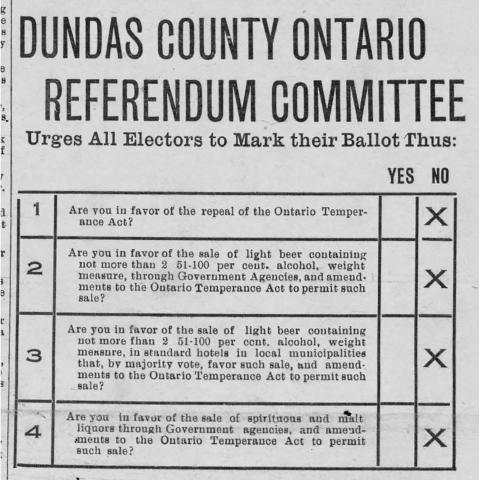
Temperance and Prohibition in Dundas County
In the pioneering days of Dundas County, liquor was cheap and widely available. It served as a persuasive tool in early elections, and as an easy incentive when one needed help to raise a building. But when the temperance movement gained popularity across Canada in the mid-1800s, some local residents began to reconsider their stance on the consumption of intoxicating beverages.
By the early 1850s, temperance organizations were being formed in Dundas, with chapters of the Sons of Temperance and the Women’s Christian Temperance Union popping up across the county in the following decades. Temperance hotels opened in many areas.
It wasn’t long before legislation was introduced that allowed communities to vote on whether to allow the sale of liquor in their districts—something known more widely as local option. Both Mountain and Winchester Townships voted to go ‘dry’ in the 1870s, but limited records from that period make it difficult to know how long the legislation was in effect in these communities.
Provincial and federal referendums in the 1890s and early 1900s showed that a majority of locals favoured banning the importation, manufacturing and selling of alcohol.
It appears that local option had been repealed in most areas of the county by the turn of the 20th century, but that was soon to change. Over the next decade and a half, almost every municipality voted on the issue, with Mountain Township adopting it in 1906, Winchester Village in 1907, Iroquois in 1909 and Matilda Township in 1914.
Prohibition was enacted in 1916, banning the sale of alcohol across Ontario. But tales of bootleggers, passed down through the generations, show that this legislation did very little to stop (or even slow) the flow of liquor in Dundas County. Those who wished to drink only needed to know where to go and who to talk to.
By 1926, public support for prohibition in the province was wavering. With an election scheduled for that December, Premier Howard Ferguson (Conservative MPP for Leeds and Grenville) made his position clear: if he was re-elected, prohibition would come to an end.
This troubled many locals, including Dundas MPP Aaron Sweet, a staunch Conservative and life-long prohibitionist from Winchester. Putting his principles before his party, Sweet chose not to seek re-election, and the county instead voted in a Prohibitionist candidate.
Premier Ferguson and the Conservatives were re-elected. True to his campaign promise, he ended prohibition in 1927 and established the Liquor Control Board of Ontario (LCBO).
Still, some areas of Dundas remained ‘dry’ for almost a half-century, preventing stores, hotels, and restaurants from selling alcohol. Iroquois went ‘wet’ in 1959, followed by Williamsburg Township in 1970 and the village of Winchester in 1973. Winchester Township held out until 1976.
Morrisburg was a unique exception, which saw an LCBO outlet and a brewery warehouse in operation by 1936. Iroquois and Chesterville opened LCBO stores in the early 1960s, and Winchester got one in 1977 after much resistance and delay. All four of these stores continue to operate today.Written by Ashley Harper
Chesterville and District Historical Society - Image
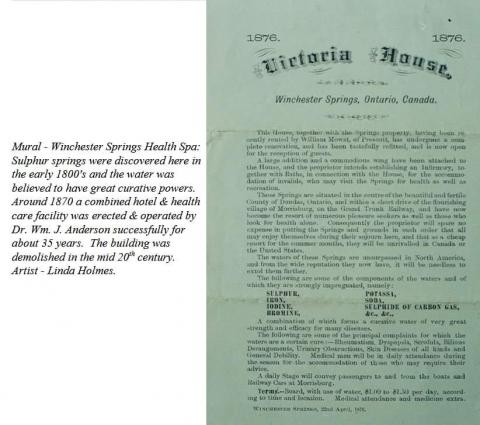
Winchester Springs Sanitarium
Did you know that Winchester Springs was once a thriving hive of activity as a resort destination? While it reached the height of its prosperity between 1876 and 1904, the discovery of the Springs dates back to 1799. Following up on local lore of a salt lick in the area that attracted wild creatures, a government surveyor named Fraser located two mineral springs on lot 5, Concession 1 of Winchester Township. However, after filing his survey, an exploratory crew was not able to locate the site when they later searched for it.
A few years later, the springs were once again ‘discovered,’ this time by lumberman Thomas Armstrong who owned a lumber yard in Winchester. Armstrong was in the area harvesting trees when he and his crew came upon the Springs. According to lore, they decided to drink the water and it allegedly cured their scurvy, which had developed due to poor diet. Whether the waters cured their scurvy is not known, but they spread the word and before long throngs of people started showing up, camping out at what was perceived to be the Fountain of Youth.
Of course, it didn’t take long for speculators to learn of the Springs. This was the era of people flocking to mineral springs all over the world. It was viewed as a cure or at least a way to treat a number of different maladies. Blue Licks Springs in Kentucky was thriving at the time, as was Sarasota Springs in New York, both harnessing the view that mineral springs can promote both physical and emotional well-being. In Canada, Carlsbad Springs near Ottawa was reaching its heyday in the 1870s.
Sometime in the late 1860s, James West purchased the property with plans for a large development at the site. His goal was to establish 78 lots over a number of streets. He also planned shops and the ‘Victoria House’ hotel. In the end, the development floundered after he had begun construction on the hotel.
This is where Dr William John Anderson enters the scene. The son of a Dundas County Presbyterian Preacher, he was born in Antrim, Ireland, but was educated in the Iroquois Grammar school and went on to Queens University. He graduated as a Doctor of Medicine in 1861 and first established a medical practice in Smiths Falls.
In 1870, when he learned of the opportunity to purchase the property, he decided to take the leap. He expanded the Victoria House into a sanitarium and a resort destination. The difference between Anderson’s plan and the failed plan of James West was that he brought with him medical credentials and a league of colleagues. He was able to offer medical treatments along with the ‘water cure.’
Under his leadership, the property was greatly expanded: tennis courts and a croquet field were constructed between meandering garden paths, all of which were hidden behind tall privacy fences. Perhaps the fences also added an allure. A report from Toronto in 1889 described the grounds as ‘delightfully shaded with maple, chestnut, pine, oak, elm, apple and other trees and velvety lawns studded with flowers.’ The grounds were about 60 acres of parks, gardens, pavilions and gazebos creating a panorama of bewildering beauty.
At the centre of the property was the Sanitarium. This was a three-storey brick building, housing 60 bedrooms, parlours, a dining hall, clinical examining rooms and bathing rooms. This was pretty advanced for the 1870s. Heated mineral spring water was piped in to fill soaking tubs. The spring water was thought to have curative qualities for maladies such as rheumatism, biliousness, dyspepsia and urinary obstructions. The ads for the resort mentioned that they had a telegraph on site so that business men would be able to keep in touch with their office. As a further incentive, there was a daily coach to pick you up or deliver you to the train station in either Morrisburg or Winchester.
The resort thrived until the death of Dr Anderson in 1904. Unfortunately, the waters could not cure him of his chronic Bright’s disease. After his death, the resort fell into ruins and the sanitarium was eventually torn down in the early 1900s.Written by Susan Peters
Dundas County Archives - Image
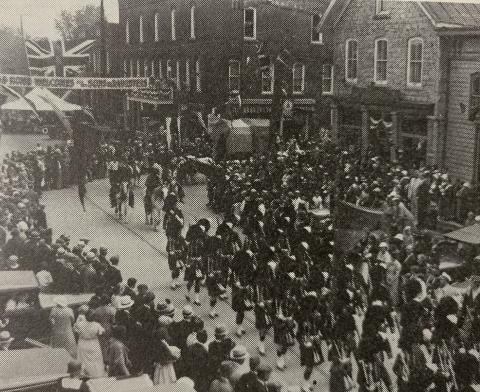
Old Home Week
In the midst of the Great Depression, hundreds of people travelled to Winchester from all over Canada and the United States to attend Old Home Week - a grand reunion for current and former residents of the district.
The idea was first proposed in the summer of 1933 by village Reeve James H. Ross, who was also the owner and editor of the Winchester Press. The plan was immediately put into motion and the Old Home Week Association was formed with Reeve Ross as chairman and local insurance agent Walter Moffatt as secretary-treasurer. Committees were organized, and residents and businesses all did their part to bring the plan to life.
From August 4th to 8th 1934, hundreds of visitors came together in these streets to celebrate the one thing they had in common - their love of Winchester and its people. There were events for everyone - old and young - including parades, concerts, midway rides, horse races, street dancing and sporting matches. The Press dedicated almost three full pages to covering the reunion.
Four years after the overwhelming success of Winchester’s Old Home Week, Chesterville decided to hold a reunion of their own. William O. Dixon, the local funeral director, served as president of the Association, aided by treasurer Howard Fulton (owner of Fulton Bros.) and secretary William H. Casselman (former MPP for Dundas). It took place from July 30th to August 3rd 1938 and enjoyed the same success as their neighbours.
One of the surviving legacies of these Old Home Weeks are two short histories of Winchester and Chesterville that were written to promote the villages and their progress. A Historical Review of Winchester, Ontario, written by Fern Workman, a long-time employee (and later owner) of the Winchester Press, was available at the reunion for just 25 cents. A History of Chesterville, written by businessman and former Dundas MP Orren D. Casselman, likely cost about the same.
Today, these brief snapshots of our communities are priceless.
Written by Ashley Harper
Chesterville and District Historical Society - Image
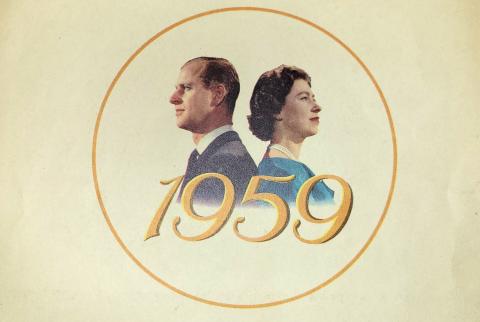
Royal Platinum Jubilee
Commemorating the Royal Visit
In June of 1959, Her Majesty Queen Elizabeth and His Royal Highness Prince Phillip, the Duke of Edinburgh, came to Dundas County to officially open the St Lawrence Seaway. After flying from England, the Royal Couple joined the Royal Yacht Britannia after opening the Seaway at the St Lambert Lock in Montreal. According to the Cornwall Standard–Freeholder, the presence of fog ‘threw carefully timed arrangements into a cocked hat.’
While they were in Ontario for 14 days, the main focus of the tour was the official opening of the Seaway. Preparations for such an event involved many hours of logistics, security and protocol. Even local groups had their hand in the planning of the event that was to take place in Iroquois.
The local newspapers of Dundas County all reported on the plans. The Chesterville Record - dated June 25, 1959 - identified the schedule and route that the cavalcade was to take. This information would be considered high-risk for planning in our current era and wouldn’t be released to the public. In 1959 however, that was not on their radar.
There was also information regarding the planned speed of the cavalcade at certain stages. The route was to follow the Long Sault Parkway at 35 miles per hour. The speed would then pick up along the ‘Queen’s Highway,’ referring to Highway 2. They would slow down again at Riverside Heights as they expected a crowd to gather, along with Morrisburg.
There was no planned stop in Morrisburg so crowds only got a glimpse of the Royal couple. The highlight of the tour was an actual stop in Iroquois. The Queen and Prince Phillip made a ten-minute scheduled stop at the new Iroquois Plaza.
Written by Susan Peters
Dundas County Archives - Image
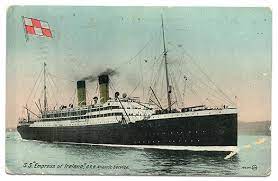
RMS Empress of Ireland
The Dundas County Connection to the RMS Empress of Ireland
When one considers the best known maritime tragedies one thinks of the Titanic and even the Edmund Fitzgerald, made famous by Gordon Lightfoot. Virtually no one knows about the RMS Empress of Ireland. This is despite the fact that the Empress lost more passengers than the Titanic. This may be because the Empress of Ireland did not have passengers who were millionaires, and business magnates such as the Allisons of Chesterville and John Jacob Astor, and Benjamin Guggenheim. The Empress of Ireland was primarily a vessel to transfer immigrants and goods.
She was first launched on January 27, 1906. The ship was part of the fleet owned by the Canadian Pacific Railway in shipping goods and immigrants between Liverpool and Quebec. At the time the CPR was one of the most powerful companies in Canada, and had created a shipping and passenger empire between the CPR railway and the Empress Hotel line across the country.
Learning from the experience of the Titanic, the Empress was fully equipped with the latest Marconi wireless telegraph, and carried lifeboats and life belts sufficient for 1800 people. The ship would carry a capacity of 1500 passengers and 420 crew. The captain, Henry George Kendall, assumed command of the ship as of May 1, 1914, after a lengthy career. The rest of the 420 crew members were split between three departments: the pursers, engineering, and the deck department.
On her last voyage The Empress of Ireland had on board 1,057 passengers. Like the Titanic, there was a distinction between First and Second Class and Steerage, each having their designated relaxation and dining areas. On the last voyage there were 87 First Class Passengers, who dined in opulence in comparison to the 700 Third class passengers who dined in a crowded cafeteria like setting.
Many of the passengers aboard the Empress were immigrants. Some stories include men who were sailing back to England to bring their bride back to Canada. Some were men returning after a business trip. One such individual was Edward Adie who came from Birmingham to meet with clients in New York. They traveled by train from New York. Some were wealthy British tourists returning home after a vacation. The Canadian Museum of History hosted an exhibit to commemorate the 100th anniversary of the sinking of this ship and it included many such stories. Contemporary newspaper accounts also shed much light on these stories. On this particular voyage there were 171 passengers in second class who were part of the Salvation Army. They were heading for a World Congress in London. One such member of this group was a woman born and raised in Dundas County. Her name was Nettie Beckstead.
Jane Etta Elizabeth Beckstead was born on the family farm near Dundela on October 5, 1871 but she was known to family and friends as Nettie. She was the eight child of Joseph and Catherine Beckstead. At aged 20 Nettie joined the Salvation Army, following in the footsteps of her older sister, Caroline. She gained her credentials as a nurse and worked in a rescue home for women in Helena Montana and later in Hamilton and the Grace Maternity Hospital in Montreal. Ironically she was not part of the original group set to travel on May 28 1914 to the World Salvation Army Congress. At the last moment, she was asked to replace an individual who had taken ill.
Image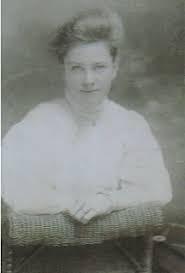
The Empress set off on May 28, 1914 from the Port of Quebec with engines humming. At the same time the Norwegian ship, Storstad was traveling in the opposite direction from Sydney, Nova Scotia bound for Montreal, loaded with 10,000 tonnes of coal. Hidden in thick fog they would collide at 1:55 am on May 29. According to newspaper reports the Empress sank within 20 minutes. Reportedly 1,012 people lost their lives, 800 bodies were never recovered. None of the Salvation Army members were recovered, including Nettie. Most died of hypothermia in the cold water. Only 465 passengers survived. 134 children lost their lives. According to the coroner’s inquest that ensued, a contributing factor may be that the crash occurred when most people were asleep as well as the confusion that ensued. Reportedly there was no time to close watertight doors and portholes that were opened for ventilation. On May 29 we should remember those who were lost in the sinking of the Empress of Ireland and especially the Dundas County native, Nettie Beckstead.
Susan Peters
Dundas County Archives - Image

Queen Elizabeth II's Visits to Dundas County
In honour of the recent passing of Her Majesty, Queen Elizabeth II on September 8, we reflect on the times she has come to Dundas County to pay an official visit. She touched so many of our lives. For most of us, she is the only Sovereign that we have known in our lives. Having recently celebrated her Platinum Jubilee was indeed a milestone few monarchs reach.
During her 70-year reign, she visited this country 22 times. Four of those visits included Dundas County. The first Royal visit with the Late Queen Elizabeth was in 1957, however, she concentrated on opening Parliament and did not make it to our region. Her first official Royal tour which included Dundas County was in 1959. Her Majesty and His Highness, Prince Phillip covered a large area of Canada between June and August with a focus on Officially opening the St Lawrence Seaway.
The Royal couple flew to Montreal and officially opened the St Lawrence Seaway on June 26, 1959. They made official stops between Montreal and Cornwall. They met with US President Dwight Eisenhower and Vice President Richard Nixon at the Moses-Saunders Power Dam. Unfortunately, the thick fog of St Lawrence on the 27th altered their plans and caused some major delays. After several stops In Cornwall, their motorcade traveled along Highway 2 with stops at Long Sault, Ingleside, Morrisburg, and Iroquois.Image
The local newspapers offered details on the route of the motorcade, where they would stop, and even the speed at which they would travel. These are details that security would never release today. However, this was a different era. The motivation was to allow as many people as possible the opportunity to see the Royal couple. As it turns out the scheduling was off by about two hours. While the motorcade traveled along the Seaway Villages, the thousands of school children bussed into Iroquois from all over the region sat and waited. There were cub scouts, scouts, brownies, and girl guides waiting in the wing. Once the Royals arrived, they were finally able to have their parade. The queen was presented with flowers and gifted some towels manufactured by the nearby Caldwell Linen Mills. Shortly afterward, she and Prince Phillip left for her yacht Brittania docked at Iroquois Point. They sailed on to Brockville. The tour continued to the Great Lakes and on to the Yukon after that.
The Queen did not arrive in Ontario again until 1964. Between October 5 and 13th, she traveled between Ottawa, Quebec City, and Charlottetown PEI. In 1967 she was back to celebrate the Centennial with stops in Ottawa and Montreal between June 29 and July 5. In June 1973 she returned for stops in most of the provinces with several stops in Ontario. The main purpose of this visit was to celebrate the Centennial of the RCMP, the tercentenary of Kingston, and PEI entering the confederation. In 1976 there was a stop at Upper Canada Village. In 1977 she celebrated her Silver Jubilee by opening Parliament again. In April 1982 she was back in Ottawa to Proclaim the Constitution. September 1984 celebrated the Bicentennial of New Brunswick, the Bicentennial of Ontario, and a visit to Upper Canada Village. July 1990 was another visit to Ottawa and Calgary. June 1992 brought the Royal couple to Ottawa again, for the 125th Anniversary of Confederation. June 1997 brought them back for another celebration. In October 2002 they stopped at most provinces but did make a stop in Toronto for the Golden Jubilee. Finally, her last official visit to Ontario was from June 28 to July 6 of 2010. She was present at Parliament Hill for Canada Day.ImageIt cannot be denied that we are presently experiencing a period of much nostalgia with the recent death of the Queen. She touched so many lives in Canada and around the world. Her image followed us on our currency, on our passports, on our government offices. No matter how you feel about the existence of the Monarchy in Canada or the drama of the younger generation, one cannot deny that Her Majesty served dutifully with much dignity and grace. For many, she was the honored grandmother figure that brought stability in a world of instability and chaos. Most of us at some point in our lives swore an oath to honor and serve our Monarch. So, with her passing it leaves a void in our lives, we are now missing an ever-present part of our lives.
Susan Peters
Dundas County Archives - Image

British Home Children in Dundas County
Between the years 1869 and 1948, over 100,000 British children were sent to Canada. These were known as British Home Children. These orphaned or abandoned children were sent to work as indentured farm workers and domestic servants. They came from an environment of extreme poverty. It is estimated that 12% of our population is descended from a British Home Child. While some did receive loving support and a caring work environment, there were many who were abused and traumatized.
Since 2011, September 28 is the British Home Child Day in Canada due to a private members Bill presented by former MPP James Brownell. The Act states that they were sent to Canada in the hope that they would have a better chance to live a moral and healthy life. However, with little monitoring by the agencies involved, many of the children faced tremendous hardships here. The Act goes on to acknowledge the enormous courage and determination of these children.
Dundas County is estimated to have received over 400 Home Children, with many enlisting in World War I. For some it was an opportunity to get back to the UK in a hope of finding their lost families. Dundas County pays homage to the British Home Children who served in the Great War. We will not forget them.
Private Frederick Thomas Baulch is named on the Van Camp Cenotaph, the Mountain Presbyterian Church Honour Roll and the Book of Remembrance of the Canadian Virtual Memorial. He was 11 when he was abandoned by his widowed mother and 13 when he immigrated to Canada in 1912. He was placed on a farm in Mountain Township. He joined the war effort from South Mountain in 1916. He was killed in action on September 27, 1918, and is buried in Calais, France.
William Campbell was born February 10, 1899 in Glasgow Scotland. He arrived in March 1913. When he enlisted on January 28, 1916, he was living in Inkerman. He served with the Eastern Ontario Regiment of the Canadian Infantry. He was reported as missing in action August 27, 1918 and is remembered at the Vimy Memorial.
Lance Corporal Arthur Endersby is remembered in the Inkerman Memorial. He was placed with William Higginson in Inkerman. He immigrated in March 1906 at age 11. He enlisted on November 6, 1914 and served with the 21st Battalion of the Canadian Expeditionary Force. He was presumed dead on May 9, 1917 and is memorialized at the Arras Road Cemetery at Pas de Calais in France. He must have been aware of his family in England, as his military records name a brother in Biggleswade who was to receive his medals and decorations.
Private Arthur Sidney Hollands was born on June 14, 1894 in Kingston upon Thames England. He immigrated to Canada at age 11. He enlisted September 14, 1915 in Morrisburg. He served with the 87th Battalion. He listed his mother as next of kin in Middlesex England, so he was not an orphan when he was placed. He died November 23, 1916 and is buried at the Contay British Cemetery at Picardie France. He is named on the Van Camp Cenotaph.
Private Walter Charles Lawrence was born in Harwich, Essex England in May 1894. His mother was identified as his next of kin in England, so presumed to be alive. He arrived in Canada in April 1912, at age 17. He was placed in Van Camp with Leonard Mills until he enlisted on February 1, 1916. He appeared to have survived the war.
Private William Edward Frederick Mead is named on the Mountain Presbyterian Church Honour Roll, and The Inkerman Veterans Monument. He was born in Hartfordshire England on December 27, 1894. He arrived in Canada in July 1903 at age 10. He was then placed with Henry Bellinger in Hallville. He enlisted in South Mountain on February 29, 1916, and identified a brother John at DePeyster Corners near Ogdensburg New York as next of kin. He served with the 4th Labour Battalion of the Canadian Expeditionary Force and later with the 38th Battalion. He was killed in Action August 10, 1918 and named on the Vimy Memorial.
Lance Corporal Horace Milne is named on the Van Camp Methodist Church Honour Roll and the Inkerman Memorial. He was born in Sheffield England on July 15, 1894, and arrived in 1909 at the age of 15. He enlisted in Morrisburg on September 14, 1915, and served with the 59th Regiment of the 77th Overseas Battalion. He died on April 10, 1917. He is remembered on the Vimy Memorial. His sister in Sheffield was listed as his next of kin.
Private Reginald Mundy is named on the Inkerman, Dixons Corners and Iroquois Veterans Memorials. He was born in London England on July 3, 1896, and arrived at age 11 in 1907. When he enlisted, he named Brinston as his address and identified his sister Annie in England as next of kin. He served in the 38th Battalion Canadian Expeditionary Force and later 77th Overseas Battalion. He was killed in action on August 13, 1916. He is remembered on the Vimy Memorial.
Private Fred Quickfall was born on May 20, 1894 in London England. He came to Canada at age 13 in 1907. We know that he was placed with Arnel Johnston of Dixons Corners, who was accused of abusing him in 1909. He was subsequently placed with Jacob Barclay also of Dixons Corners. On March 28, 1916, he enlisted in Morrisburg. He served with the 2nd Battalion of the 154th Overseas Battalion. He died on May 5, 1917. He is buried at Bruay Communal Cemetery Calais France.
Lieutenant William Thwaite was born on March 15, 1892 in Newcastle in Tyne, England. He was the youngest of 11 children and only 3 months old when his father died of a heart attack. By 1903 his mother also died. The children were taken into care and by 1905 Willie was being sent to Canada at age 13. He’s a clerk in a Dry Goods store in Iroquois. In 1911 he was a salesman boarding in the household of the Jackson Family in Matilda Township. He enlisted in Iroquois on March 7, 1916, and served in the 38th Battalion of the Eastern Ontario Regiment and commanded the Iroquois Platoon of the B company of the 154rth. He died on August 10, 1918, and is buried in Somme, France.
If you descend from any of these men, the Dundas County Archives would love to hear from you.
Susan Peters
Dundas County Archives - Image
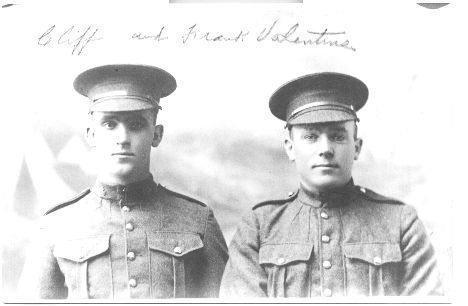
Remembering Local Veterans
Asking for assistance from the public as we remember those who served.
It is at this time of year that our thoughts go to those who served in the military for our country in war, and those who gave the ultimate sacrifice. Most people know of a father, brother, uncle, or grandfather who served in one of the world wars. Every year on November 11th we remember those who have fallen. Every November 8th is Indigenous Remembrance Day. However, as of November 12th, we move on to the next commemorative event and put it all on the back shelf of our memories until next November.
I personally feel that given their sacrifice; we should all do more to remember those who served. I grew up in the military and in military bases in France and Germany. As a child, I developed an extraordinarily strong appreciation for these brave individuals, as I toured many memorials and Cemeteries in France, Germany, Belgium, and the Netherlands. One develops a strong view of our place in history with such firmly placed roots. I also worked in the National Defense Archives and on various contracts researching military history. I am also the daughter, mother, and granddaughter of serving members of the military. In fact, my family served for many generations. I guess you can say that the sense of duty is strong in my family, so this motivates me.
As a result, I am committed to a project which will provide a resource by which veterans will be remembered all year long. This is an online resource identifying the veterans who served from Stormont Dundas and Glengarry counties. As the archivist for Dundas County, I am working on building a collection of memorials for those from Dundas County. I need your help. I would like to be able to provide basic information about each veteran. I reach out to those who have family members who should be remembered in this collection of memorials. If you have a family member or know of someone who should be included, I would very much like to hear from you.Image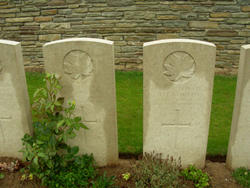
The site will be called S D G Veterans remembered. It is presently a work in progress. As previously mentioned, my responsibility in this project is for memorials for Dundas County. I would like to collect information, but also photos. It is my hope that we will be able to locate the story of every Dundas County Veteran, from any war, including the Boer War, the First and Second World war, the Korean war, and every conflict since then. But one step at a time and with respect. If you have anything to share with this project, please send me an email at dundascountyarchives@gmail.com. I would very much love to hear from you. If you are related to anyone named on the Van Camp Cenotaph, I would love to hear from you. In another project, I am putting together the stories of these men named on the Van Camp Cenotaph on Levere Road in Mountain Township.Susan Peters
Dundas County Archives New donations at the Dundas County Archives – the Williamsburg Times 1932 - 38
There have been lots of exciting donations coming into the Dundas County Archives in the last few months. We have large collections of photos of pre-1900 North and South Dundas County, there are letters from the mid-1850s, and a number of other correspondence which have recently been donated. I have also been working through the archive of the Syberon / George Beavers dental companies. These began with Briggs and Challies who produced dental powders and the first toothbrushes manufactured in Canada. There will be more on this later but for this installment, my focus is on Christmas.
Image
A week ago I received an amazing donation of the full run of the Williamsburg Times. These were published in Williamsburg during the height of the Dr. Locke era. While they did focus on the activities in that village it did have a much wider interest. It was because of Dr. Locke that Highway 31 was paved. The Ferry from Waddington brought many people from Waddington to see Dr. Locke. People in Williamsburg, Morrisburg, and everywhere in between prospered by being able to run a business housing, feeding, and doing laundry for those who came to see Dr. Locke. The wheelchair boys were able to earn an extra income pushing wheelchairs with clients to see the Dr. The area saw movie theatres, restaurants, hotels, and other businesses thrive during the Great Depression. It was as if the depression bypassed the region. There was even a floating hotel in Morrisburg. There were advertisements in these newspapers for businesses in Winchester and Chesterville as well and the papers did cover the news for the whole County. They are essentially a window into the local world from 1932 to 38.
One of the ways in which these early newspapers can provide a glimpse of the world is through their coverage of more domestic aspects. Most of these issues in the Williamsburg Times had a column called “Good things to eat”. These were created by Miss Helen Lacey. Some of the recipes that she provided were commonly in use today. Others are reflective of a time gone by and are of foods that have lost their favor in our modern era. I was interested to see how she depicted the recipes for Christmas. Some might have lost their shine with a modern audience, such as a pineapple and cheese salad. The same can be said for liver salad, or scalloped liver and rice. However, some of the Christmas recipes are timeless.
Image
Why not pay homage to those who lived in this area in the 1930s by trying one of these recipes for your Christmas feasts? According to Miss Lacey, we might have already missed the boat with being too late to prepare the annual Christmas Pudding as it will not have had the time to properly age in rum. But there are plenty of other things that can be prepared to celebrate or festive season. If you do try one of the recipes I would love to hear how it all went. Please send me photos.
December 3, 1937
Christmas Cocktail- 2 cups cranberries
- 2 cups water
- 2 whole cloves
- ¾ cup of sugar
Wash cranberries and cook with the two cups of water and the cloves. When tender, strain thoroughly.
Add sugar to the liquid and cook long enough to blend thoroughly. When partly cooked, add lemon juice. Serve with ice cubes.
Christmas Salads – Jellied pineapple salad- 1 pkg lemon jelly powder
- 1 cup shredded pineapple
- 1 TBSP lemon juice
- 1 cup boiling water
- ¼ cup blanched almonds
- 1 orange, diced
Add boiling water to jelly powder stir until dissolved. Add lemon juice and pineapple and cool until it begins to stiffen. Stir in chopped almonds and diced orange and pour into a jelly mould and chill. Unmould just before serving on lettuce leafs.
Shortbread cookies- 1 cup butter
- 1/3 cup fine granulated or fruit sugar
- 2 cups flour
Cream the butter, add sugar, and gradually cream together. Add flour slowly when a stiff dough is formed turn it out on a floured board. Gradually knead. Roll out ¼ inch thick and cut into fancy shapes. Place on a baking sheet and bake in a slow oven until golden brown.
Susan Peters, Culinary Historians of Canada
Dundas County Archives
dundascountyarchives@gmail.com- Image
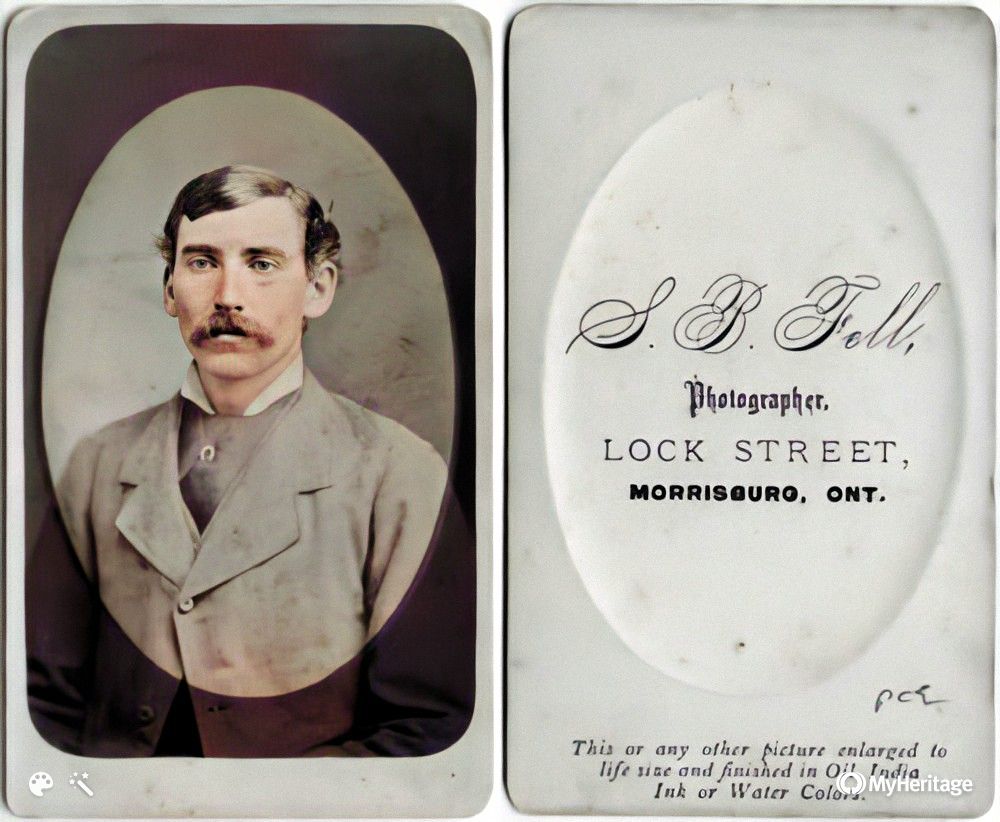
Letters home from Dundas County soldiers on the Western Front – WW1 The Canadian Letters and Images Project
As I have continued with my research into the stories of veterans who served from Dundas County, I have made an amazing discovery. It is one thing to collect the data on an individual, details such as date of birth, parents, where they served, and such are all important. It is another thing, though, to be able to learn their voice and their most inner and personal thoughts. For two men who served for Dundas County in the First World War, I have found collections of their letters from the Front. One man is Private Clifford Shaver, who is named on the Van Camp Cenotaph. The other is Frank Beecher Doran from Iroquois.
Image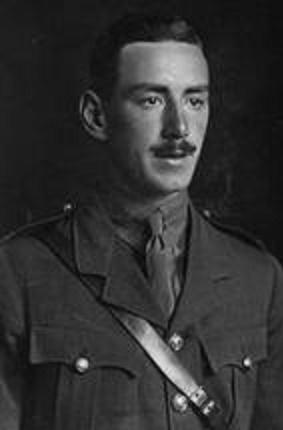
I have found the military records for both men. Both died in service in the First World War. Both men died in their prime, in their early 20’s. Both men left behind family to mourn for them. Through the Canadian Letters project, we can see into the window of their world from the Western Front. It helps to put a face on these men. This is an utterly unique collection of documents, as very few of these personal letters still exist.
The Canadian Letters and Images Project is an online archive of Canadian War experience, as told through the correspondence of Canadians. The project is based in the Department of History of the Vancouver Island University. The letters are scanned and transcribed. Some collections include photos and other related documents. This is an incredible resource for individuals studying the daily life of soldiers in the First World War. If you are lucky enough to have a family member represented in the collection, this would be a rare chance to get to know your relative better. Of the two men in my study, Private Clifford Shaver and Lieutenant Frank Beecher Doran, both wrote to their sisters. There is a definite air of conviviality, and brotherly advice. Both report about the tedium of training and mention things missed from home.
Lieutenant Frank Beecher Doran was born in Iroquois, the son of John and Annie Doran. He was a teacher before he enlisted on March 28, 1916. He was married to Minnie Frances Caldwell on May 8, 1916, so went off to war as a newlywed. However, the 5 letters in the collection are to his sister Martha. They run from September 17, 1916, in Military Training Camp in England to July 10, 1917, in France. He teases her about her name. He wrote about how exhausted he is at the end of the day. Iroquois was referred to as “Gods Land.” This denotes an air of home sickness. He said that drills and discipline was simply tyrannical. It is sweet that he did give his sister some brotherly advice such as “be nice, don’t be selfish and have a sunny disposition.” You can tell that there is a connection between them as he signed his letters, “your ever affectionate brother.” Something that only a brother would ask, Frank did ask about her current flame but suggested that she would have more fun if she was not going steady with one beau. When he was not giving her advice, he was describing the conditions in the trenches. His last letter was July 10, 1917. Sadly, he was killed in action August 14, 1917.Image
Frank Doran served with the Canadian Infantry Central Ontario Regiment initially but when he was killed in action in Ypres, he had been transferred to the Royal Flying Corps. He was 23 years old when he died. Frank is buried at the Mendinghem Military Cemetery in Belgium. He is also named on page 229 of the Veterans Book of Remembrance.
Image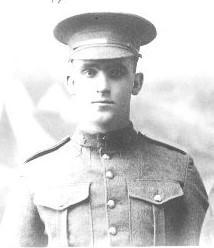
Clifford Shaver was born in 1896, in Mountain, Ontario, the son of William and Jessie Shaver, the youngest of 10 children. Clifford enlisted in the Canadian Infantry (Eastern Ontario Regiment) on February 1st, 1916. In the letters Clifford shared an incredibly challenging experience in the Front, doing 40-day rotations in the trenches, interspersed with episodes in quarantine back in England. The letters to his sister Teena are dated January 21, February 4, April 1, June 21, September 7, and December 20 in 1917.
In these letters home he covers the topics of local boys who are there with him. He writes about the tedium in training camp and the desire to get on with it. He also critiqued the food in camp. By June he is in France and getting training for gas attacks. Clifford mentioned that he was writing the letter on top of his helmet as there was no other place to do so in the trenches. He did thank his family for the care packages. Apparently mail from Canada was coming in about once a week that the packages brought comfort. The letters also shared the hope that the war would be over soon, and they would be able to go home. Sadly, Clifford did not make it home. The last two letters notified his mother that he was killed in action on October 30, 1917, and buried on the ridge at Passchendaele. He was 21 years old. He is remembered at the Van Camp Cenotaph and the Menin Gate, Ypres Belgium.
Image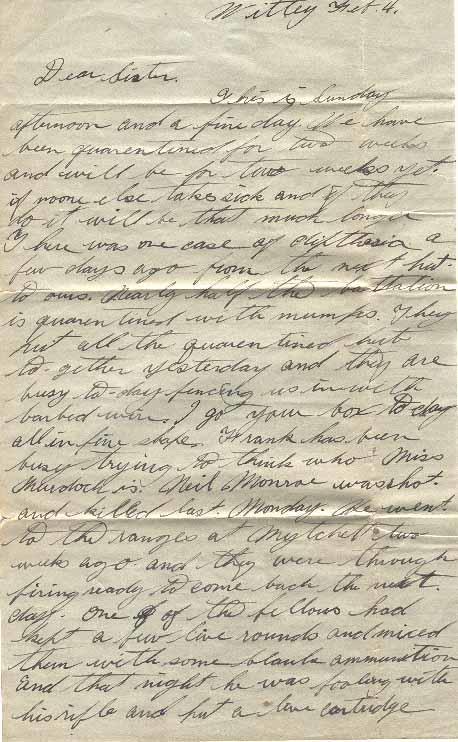
Letters home from the Western Front were deeply personal. Over the years very few of these precious documents have survived the ravages of time. As such, this is an exceedingly rare collection for researchers of the era of World War one. The University of Vancouver Island is to be commended for this project which offers a unique window into the world and into these soldiers' life. It certainly helps to put a face on the names of those remembered on our cenotaphs.
Susan Peters
Dundas County Archives - Image

Celebrating Black History Month in Dundas County
The Dundas County Archives has conducted research in honour of Black History Month. It is important to look at the Big Picture within the context of the time. Under the Imperial Statute of 1790 settlers were permitted to bring their enslaved servants to Upper Canada. Since this region was settled by United Empire Loyalist refugees from the American Revolution, they were within their rights to bring with them any property, and under the law that included those who were enslaved by them. Unfortunately there are few records about any of these individuals in this immediate area.
According to Judge Pringle in his book Lunenburgh or the Old Eastern District, (1890), we do know of one family of enslaved under the name of Baker, who settled in Cornwall along with the Loyalists. John Baker was one of the last loyalist slaves living in Upper Canada when he died in 1871 in Cornwall. His great grandfather Cato Prime, had been born in Guinea Africa. He was owned by John Low of Newark New Jersey. Cato’s daughter Levine, gave birth to Dorine, who was the mother of John Baker. Their owner, through marriage, became Captain James Gray of the 42nd Regiment, the Black Watch. It was through this family that Dorine came to Upper Canada. She married either a German or Dutch man, depending on the source, and had a large family. John was the second son. Although the father was a free white man, under law the child of a slave maintained the legal status of the mother, so her children were also enslaved. In 1804 the children were all freed due to manumission papers in the Will of their owner, Robert Gray. John was also left 200 acres of land near Cornwall.
John Baker, once free, enlisted with the New Brunswick Fencibles and served in the 104rth Regiment in the War of 1812. He also served with the British Army in Europe during the Napoleonic War. Afterwards, he returned to Cornwall and became an active member of his community.
Captain Justus Sherwood of Prescott, another loyalist, brought with him his slave Caesar, (also known as Scipio) with him when he settled in the area. Very little is known of his story but apparently he was freed and married a black woman and settled in Brockville.
Daniel Jones, of Brockville, had a slave by the name of Elizabeth. One record exists pertaining to the sale of Elizabeth on August 30, 1788. Jones had sold her to Doctor Solomon Jones of Augusta for 25 pounds Halifax currency. In Kingston, the pioneer loyalist Anglican Minister, the reverend John Stuart, mentioned his slaves in his Will. He left his wife his slave Louisa and her children. Another member of the clergy, Reverend John Bethune of Williamstown Presbyterian Church in Glengarry had slaves.
Lieutenant Governor Simcoe created the Act to Limit Slavery in Upper Canada in 1793. This was the first legislation in the British Colonies to restrict the slave trade. While there was strong opposition to the bill. It legislated that no more slaves could be brought into the Province. Those who were born enslaved prior to that date would gain freedom at age 25. In 1819 The Attorney General, John Beverly Robinson declared that enslaved individuals were declared free if they resided in Upper Canada. In August 1833, the Imperial Parliament freed all slaves in the British Dominions. This was almost 30 years before slavery was abolished in America. With the passing of the Fugitive Slave Act in USA in 1851, any slave who escapes can be retrieved by their owners or an agent and returned to slavery. This created the incentive for enslaved runaways to travel to Canadian soil. The region of Southwest Ontario became the hotbed of the abolition movement and home for many of these fugitive slaves. There is little information about blacks escaping to the St Lawrence River region, however, due to the fact that this was an underground movement.
Census records of 1851 and 1861 do name very few black individuals in Dundas County, but we have no idea if they are fugitive slaves of free. London Derry resided in Williamsburg in 1851, he was also known as London D Lunn in 1861. But spelling was very inconsistent in the census records. I could not find any background information on this man or his family.
Image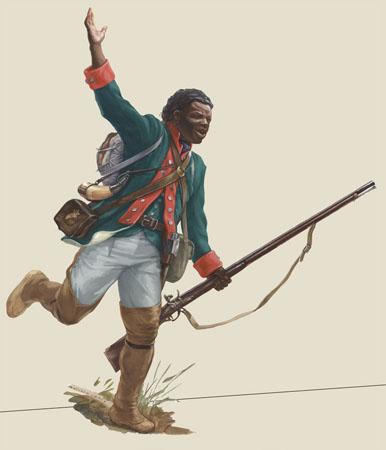
Isaac Johnson (1844 – 1905) was born in slavery in Kentucky. He joined the Union Army during the Civil War and gained his freedom through the Emancipation Proclamation which freed all slaves in America. While he did write an autobiography, he never really states how he ended up in Dundas County. After the Civil War he wandered for a number of years, as a labourer, and ended up in Morrisburg and then Winchester around 1870. He served as a contractor and stone mason. He was employed in the construction of a number of buildings, including the Winchester United Church, and the St James Anglican church in Morrisburg. In December 5, 1905, he married Theodosia Allen of Morrisburg. A notice of this marriage appears in the local newspaper. Together, they had six children. In those days the border was pretty fluid, and he was engaged in a number of other projects in Ogdensburg and Waddington, New York. He wrote Slavery Days in Old Kentucky as a means to provide income to his family when he was injured on a job. Isaac died on December 5, 1905.
The records pertaining to blacks in Dundas County are very sparse. Records of the United Empire Loyalists could provide more information as to their property, but that is a challenge to decipher. As such, we know very little of those who lived in this region or their stories. Upper Canada Village is hosting a special exhibit in the coming season on the history of Blacks in the region. I look forward to seeing what records they have been able to find. In the meantime if you have any knowledge about any Black history in Dundas County I would love to hear from you.
Susan Peters
Dundas County Archives
dundascountyarchives@gmail.com Quite a Fisherman’s tale – A sea monster in the St. Lawrence - 1922!
There has been a long history of tall tales of creatures living in the local waters. Some consider these to be myth or legends, somewhat akin to fairytale stories. One’s imagination can work havoc on one when they are not sure what they have seen. Others have taken these stories much more seriously.
Image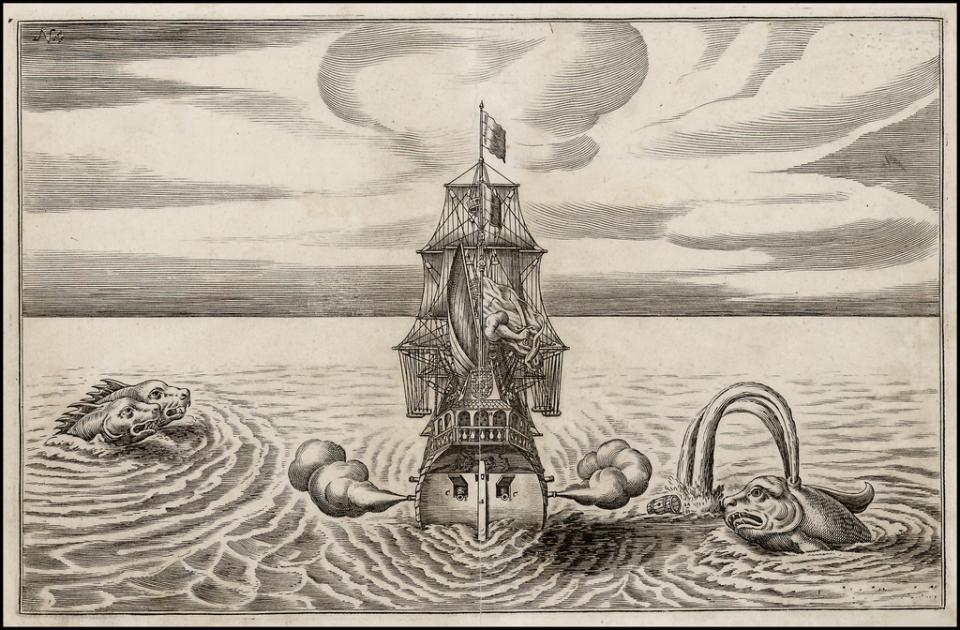
There have been indigenous oral traditions of fantastical creatures in the St. Lawrence River. They were known as Kaniatarowanennah by the Mohawks. According to Mohawk legends, there have long been creatures living in the river, and they were known to be highly territorial. They were allegedly known to attack anyone who ventured onto the river alone. These creatures were known as Wakandagi.1 The stories tell of long, serpent like creatures which were covered in scales. They were told to be capable of tipping canoes and would focus their aim on those canoes who had only one occupant.
The earliest official reporting that was noted for a “monster serpent” in the St. Lawrence River took place in 1822. Ten witnesses in a voyageur canoe stated that the saw a sea serpent ascending into the St. Lawrence. Two of these individuals were willing to sign an affidavit in front of a judge as evidence.2 Unfortunately, I was not able to locate said document to confirm. It is not known if any further investigation occurred. Newspapers of that date do not seem to be available to research.
In 1833 there were numerous reports of a creature seen close to Kingston, Ontario, especially by Captain Kellogg, and several crew members and passengers. In fact, there were so many sightings that the mythical creature was assigned a nick name: “Kingstie.” Most of the reports were of a huge snake-like creature ranging from 20 to 40 feet long.3 Some reports were that it had devilish eyes and horns, others said the creature made a terrible roar.
The next big fish story of the St. Lawrence River was published all the way in Wilmington, North Carolina, on June 11, 1857. The Wilmington Commercial reported an article about such a sighting with the headline of “A monster serpent in the St. Lawrence."4 In this article it states that a resident of Mallorytown has reported a sighting of an “enormous water serpent,” seen numerous times. A Mr. L. Parker of Three Mile Bay and a D. Ladd have also seen such a creature. They described the creature as having raised its body at least 6 feet out of the water and it allegedly pursued the boat and chased them. They further described the creature as being over thirty feet long. There were further corroborating sightings by a boat crew around that time.
Fast forward to 1888 to another story of Kingstie. Two men canoeing near Kingston claimed to see a large water serpent. They reported that “the monster passed us so close that when we stopped, that we could see him distinctly and judged him to be at least 15 feet long. He was six feet out of the water."5 Apparently, the story had enough of a following that young ladies were refusing to go into the St. Lawrence or Lake Ontario.
Dundas County was the hotbed of sea creature sightings in 1922. A search through newspapers of 1922 brings up all kinds of reports on sea creatures around North America so the topic was certainly one of interest to the public.6 There were reports of monsters attacking near Florida, as well as on the Pacific coast and several reports around Newfoundland.7 But more significantly there were several reports at Iroquois in the summer of 1922. While some reports label these sightings as a hoax, such as the Kingston Daily Standard of Monday July 24, 1922,8 said that they failed to find any confirmation to the recent dispatch stating that a monster, resembling a sea serpent has been seen in the St. Lawrence at that point. No person has been found who has seen anything out of the ordinary, in the waters near Iroquois.
Image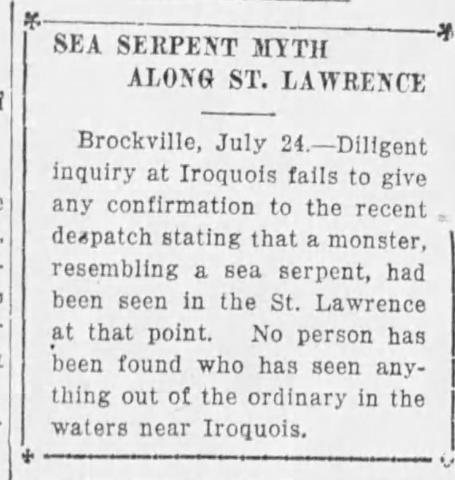
On August 10, 1922, the Daily British Whig (Kingston) claims there is “No Hoax whatsoever.”9 Quoting the Iroquois Post and Lt Col Lorne Mulloy stating that “the persons who reported seeing such a monster must have been under the influence of homebrew.”10 This was also copied in the Ottawa Citizen, the Cornwall Freeholder and Kingston Daily Whig. Whether you believe the stories or not, there were those who were convinced that they saw a large volume of water rising abruptly in the river. There was no one dynamiting the river at the time, yet several others saw the water disturbed the height of a house. The Kingston Whig states that since there were significant reports of either water being displaced or a sighting of a sea serpent, then it must have been true, “therefore the Whig believes that the story sent to is no hoax, and that some kind of water monster has made it way up the river from the sea.”11
It is interesting to note that an article that appeared in the Newton Alabama Southern Star blamed climate change for the recent reports of sea monsters appearing in the Northern Hemisphere.12 It was reported that many sea creatures that would normally been only found in the southern hemisphere or deep in the sea are appearing where they were never before been seen. The cause must be “Climate Change.” This was in 1922! Whether the sea monster stories outside Iroquois were to be believed or not, it is certain that the reports gave Dundas County a moment of fame. I could find no other reports of a creature after 1922 in the newspapers. The construction of the St. Lawrence Seaway certainly changed the path of the river and which species would thrive or perish. While sturgeon were prevalent prior to the Seaway, they are rare now. Maybe these people saw a large sturgeon? We will never know for sure.
Do you have any monster fish stories you might want to share?Susan Peters
Dundas County Archives
dundascountyarchives@gmail.com- [1] Haunted Montreal May 13, 2020, The 57th installment of the Haunted Montreal Blog
- [2] “Sea Serpent” Written by Lynn E. McElfresh in Thousand Island Life Posted March 14, 2018
- [3] Lynn E McElfresh “Sea serpent” March 14, 2018, in Thousand Islands
- [4] Wilmington, North Caroline The Tri Weekly Commercial. June 11, 1857, reporting from the Brockville Monitor
- [5] “Sea Serpent” by Lynne E. McElfresh
- [6] Kingston The Daily British Whig Wed March 29, 1922, page 13 Vancouver machine guns and traps set to exterminate sea monsters
- [7] El Paso Herald (Texas) Friday August 25, 1922, page 1; The Brantford Expositor Brantford Ontario Wed August 30, 1922, page 7; The Kingston Daily Standard Sept 14, 1922; Kingston Daily Whig Sept 19, 1922, page 1
- [8] The Daily Standard, Kingston Monday July 24, 1922 page 2, citing a report from Brockville
- [9] Kingston The Daily British Whig. Thursday August 10, 1922, page 6
- [10] Cornwall Ontario, “Hubub in Iroquois” Cornwall Freeholder 12 Jan 1922, page 2 and Cornwall Freeholder “The Iroquois Monster” 24 August 1922, page 6
- [11] Kingston The Daily British Whig Thursday August 10, 1922, page 6
- [12] Newton Alabama Southern Star Wed December 20, 1922, page 1
Arthur Sidney Hollands 1894 – 1916
One often encounters roadblocks and challenges in the process of research. This is the case when trying to piece together the story of a life lost in the line of duty in a distant war. In this case brick walls were discovered while researching those named in the Van Camp Cenotaph near Mountain Ontario. The individuals referenced on the monument were so much more than simply a name. They were brothers, sons, nephews, friends, and lovers. They had dreams and aspirations that were all snuffed out way too soon. They were individuals with their own stories, and they deserve to be remembered and honoured for their sacrifices.
Image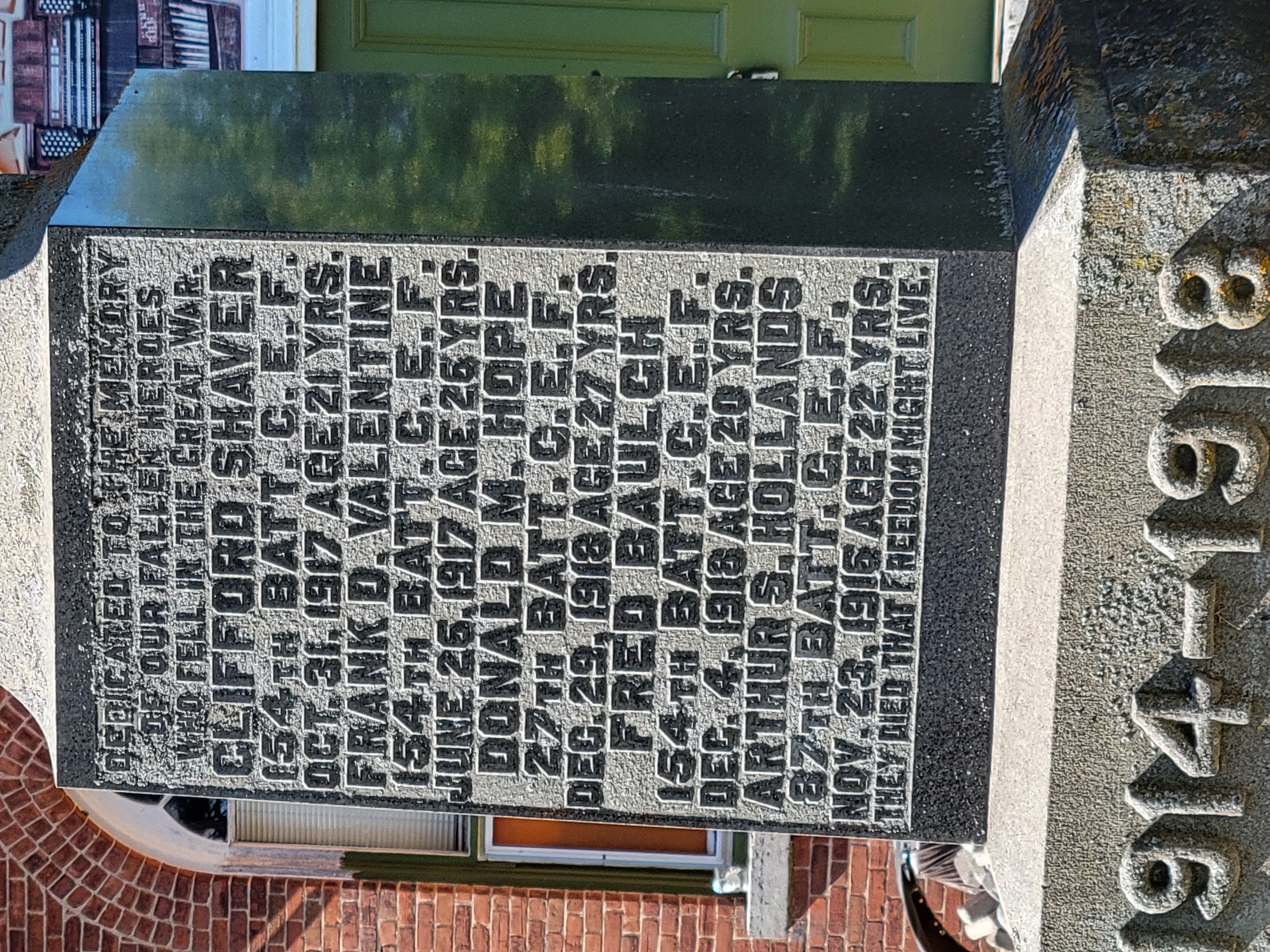
In the five names listed on the Van Camp Cenotaph, remarkably two of them were British Home Children. Between 1869 and 1948 over 100,000 British children were sent to Canada to be placed as farm hands, domestic servants and general labour. They ranged in age from 4 to 16 years old when they were sent to Canada and Australia. It is estimated that 12% of our population descends from a British Home Child. We do know that over 400 of these children were sent to Dundas County. Unfortunately, we have extraordinarily little information about where they were placed in the county. It also takes some digging through various archives to learn where they came from in the United Kingdom.
Arthur Sidney Hollands was one such individual. His World War 1 attestation record states that he was born June 14, 1894, in Kingston upon Thames England. His trade was listed as farmer, so one might assume that he was placed on a farm as a child. It is not until you dig into the records of the British Home Children Programme, that you are able to confirm that Arthur Hollands was indeed from their ranks and was listed in the British Home Child Index as being transported on the Ship “Dominion” and he does appear on the ship's passenger list departing from Liverpool on 12 September 1907. He arrived in Quebec on September 22. He was only 11 years old. Once can only imagine the emotional strain on Arthur to have gone through this all alone at such an immature age.
I tried to learn more about his family background in England. As I knew that the sending agency was Barnardo’s I consulted with their archives. Technically the institution he was surrendered to was known as the National Incorporated Association for the Reclamation of Destitute Waif Children. It was more commonly referred to as Barnardo’s Home. It was a British charity founded by Dr. Thomas Barnardo in 1866 to care for orphaned and abandoned children. They are very tight with their records and have a strict policy that to access any records one must prove that they are next of kin. As I am not related, that was a brick wall. So, I turned to the public record. He does appear in the 1901 England Census in Kingston Upon Thames. His mother is listed as Jane Hollands aged 35, widow. She is a domestic Servant. Her daughter Louisa is listed as age 14, also a domestic servant. Arthur is listed as 6 years old, and his younger brother was Alfred, aged 4. Other than his name appearing on the passenger list for the “Dominion” in 1907, he is hard to find in any public records.
Family research uncovered that he had several siblings. Louisa was born in 1886, Leonard was born two years after Arthur, in 1896 and Ena was born in 1906. We do not know if any of the siblings were surrendered by their mother to Barnardo’s along with Arthur.
Not finding any records in England, I returned to Canada. The Canada Census of 1911 has Arthur placed as a domestic labourer in the farm household of Walter and Maud Scott in Hastings County near Belleville. It also states that he immigrated to Canada in 1907. The household also had another British Home Child, Mildred Lucas aged 9, who also immigrated from England in 1907. Both were able to read and write. This was not always the case. How he ended up in Mountain Township, Dundas County, is anyone’s guess. The records are elusive at best. The next place where he shows up is in his attestation record when he enlisted in the Great War in 1915. He listed his mother as his next of kin. He gave her current address, so he was clearly not an orphan.
It is interesting that while his mother is listed as his next of kin, he has a Military Will in his personnel file which names Miss Katie M Bellenger of RR 1 Mountain Ontario as his beneficiary. He further states that she is to receive his medals upon his death. Looking through the file we can see that she also received his pay. Sadly, he was killed in action on November 23, 1916. He was listed as a casualty of the 87th Canadian Grenadier Guards. He is named on page 104 of the Official Book of Remembrance with Veteran’s Affairs.  He is buried at Contay British Cemetery in Contay, Picardie, France.
Image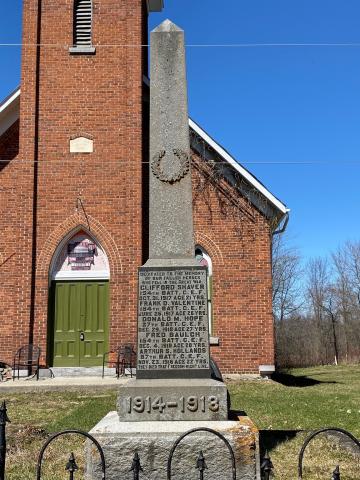
So, what happened to the service medals? My next step was to try to find Katie Bellinger. The 1911 Census of Dundas County identifies that she was born to John Bellinger of lot 102, Concession 6 and his wife Viola in 1896. She was married on January 22, 1919, in South Mountain to Matthew Hastings. It is interesting that Katie married another British Home Child. According to the 1921 Census, Matthew had immigrated to Canada in 1911. He is listed on the British Home Child registry as departing Liverpool on February 26, 1911, and arriving in Halifax on March 9, 1911. His placement was with Kenneth Guy in Mountain. He was 16 years old at the time. He was listed as being placed with Barnardo's. Odds are that since he was in Mountain as of 1911, he could have known known Arthur Hollands. But we do know that three years after Hollands was killed in action in France, Matthew married the woman who inherited Hollands’ medals. They went on to have a son named Roy and grandchildren Paul, Bob, Don, and Mary. If anyone knows any of these people and can shed any light on the relationship between Arthur Hollands and Katie Bellinger – Hastings, I would love to hear from them.
Susan Peters
Dundas County Archives
Dundascountyarchives@gmail.com- Library and Archives Canada Personnel Records of the First World War, Canadian Expeditionary Force (CEF) RG 150, accession 1992 – 93/166 Box 4443-3 Item 464542 Regimental Number 145193 File Arthur Hollands
- 1911 Census for Canada. Ontario. Hastings West District 80 subdistrict 12 under the household of William Scott
- British Home Child Registry. British Home Children Advocacy and Research Association. File 21456 Arthur Sidney Hollands Library and Archives Canada British Home Child Index. Sending Organization Bernardo's
- RG 13 / 662 1901 Census of England District 5 Kingston upon Thames National Archives Kew
- Military service file for Arthur Sidney Hollands
- 1911 Census of Canada Dundas County Mountain Township page 1901 10
- Ontario Canada Marriages 1826 – 1939. Marriages 1919 Series Ms 932 Reel 506
- British Home Child Registry. Home Children Canada
Dundas County’s Connection to “In Flanders Fields”
Every November 11th, Canadians gather to honour and remember those who gave their lives in service to the nation. Remembrance Day conjures up memories of military parades, wreath-covered cenotaphs, and the mournful tunes of the ‘Last Post’, but for many, nothing recalls Remembrance Day more than the recitation of “In Flanders Fields”. Perhaps the most prolific war poem ever penned, the words of Lieutenant Colonel John McCrae continue to resonate with those who have suffered through conflict and war, and those who have lost loved ones to such strife.
While the poem is deeply ingrained in Canadian culture, it has an even deeper connection with Dundas County, a connection that most never knew existed. Lt-Col. McCrae wrote the poem on May 3rd, 1915, after presiding over the funeral for his friend and fellow soldier, Lt. Alexis Helmer who was killed in action during the Second Battle of Ypres the day before. McCrae was struck by how quickly poppies were growing on the graves of the soldiers, and inspired by the death of his friend, created one of Canada’s best known literary pieces.
Lt. Alexis Helmer was born near Ottawa to Richard A. Helmer, a Brigadier General from Russell, who was a member of the Helmer family of Dundas. Alexis’s grandfather, Nathaniel Helmer, was born in Williamsburg Township, Dundas County, and raised just over the county line in Russell. The Helmers were early Loyalist settlers to Dundas, and like Alexis were called to serve in defense of their homeland. Richard Helmer, great grandfather of Alexis, served in the “1st Dundas Militia” at Prescott during the Rebellion of 1838, and Johannes Pillar, great-great grandfather of Alexis, served with the Dundas Militia at Crysler’s Farm in 1813. Alexis Helmer volunteered to defend Canada overseas, as his ancestors had defended their Dundas homes one hundred years before, and sacrificed his life in service to our nation, inspiring one of the most beloved and poignant poems in Canadian history.
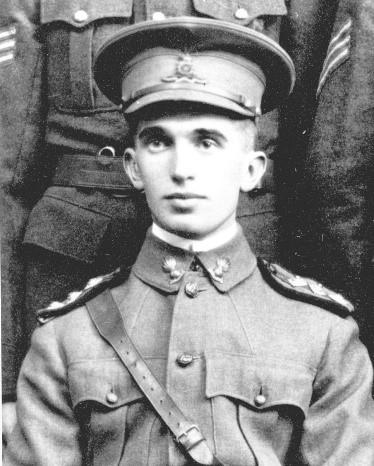
Lt. Helmer is not the only Dundas connection to John McCrae however, as before he was a Lieutenant Colonel serving in Flanders, he was a Lieutenant serving in South Africa. During the Boer War, McCrae was an officer in ‘D’ Battery of the Canadian Field Artillery, and one of his Gunners was Duncan Macdonell, from Iroquois. Macdonell had served in the local 56th Grenville Rifles, and had volunteered with the Canadian Artillery, serving in South Africa in 1900.
Undoubtably, he knew Lt. John McCrae, and due to his conduct during the war there is a strong possibility that McCrae knew him as well. Macdonell was commissioned as an officer in the British Army’s “Royal Berkshire Regiment” in 1901 as a result of his gallant service with ‘D’ Battery, and he remained in South Africa until the end of the war in 1902. Like McCrae’s father, Duncan Macdonell’s father had raised a militia artillery company during the Fenian Raids of 1866-70, serving as the commanding officer of the Iroquois Garrison Artillery.
“In Flanders Fields” has become one of the most well-known war poems in history and is read aloud at ceremonies across the world every year on Remembrance Day. The feelings evoked by the words of John McCrae are timeless, and the pain caused by the death of his friend, Lt. Alexis Helmer, is a pain that was all too commonplace during the Great War. While few remember the story of Lt. Helmer and how he inspired those hallowed verses, fewer know the connection to Dundas County through the Helmer family, and the service of Dundas men in the Boer War and WW1. Indeed, one of the county’s first casualties of the Great War, Charles B. Forward of Chesterville, was killed in action during the Second Battle of Ypres, just two weeks after Helmer fell. Private Forward has no known grave, but his memory, and the memory of hundred of thousands of other soldiers will be honored each year with the wearing of the poppy and the ceremony of remembrance.
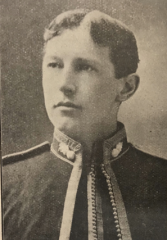
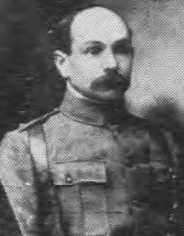
Today, the Helmer name is still found across Dundas County, and though more than 100 years have passed since his death, Lt. Alexis Helmer and the poem he inspired continue to live on across the world, ensuring that, for all time, we will remember them.
Authored by: Axel Ravera
As presented on October 22, 2023 at Van Camp ceremony
Today, we gather to honour the five men named on the Van Camp Cenotaph. They were so much more than a name. They were sons, brothers and friends. They had dreams and aspirations. They all answered the call to serve, and they lost their lives due to their service. They should be remembered and honoured for their service.
It is noteworthy that of the five men named, two were British Home Children. Between the years of 1869 and 1948 over 100,000 British children were sent to Canada to be placed as farmhands, domestic servants and general labour. They ranged in age from 4 to 16 years old when they were sent to Canada. Not all were orphans. They were all living in a state of poverty at a time when the British government felt that they would be best served to be separated from family and taught skills and trades. While there were several different sending agencies in England and Scotland both men serving from Van Camp were sent through Barnardo’s Homes. Of the two men who served from Van Camp, both were given up by their mothers after their fathers died and they were impoverished. This does not appear to be an unusual situation with the British Home Children. It is estimated that about 12 per cent of our population descends from a British Home child.
Private Arthur Sidney Hollands (1894 – 1916) was one such British Home Child. I was able to ascertain that he was born on June 14, 1894, in Kingston Upon Thames England. His father died in a Mill accident around 1899. His mother had surrendered him and his brother Leonard when he was 12 years old and his brother 10. The boys spent some time in a children’s home before Arthur was sent to Canada in 1907. According to Barnardo, he was sent to several different placements in Ontario before settling in South Mountain in 1911. It is not known where he was placed, but we do know that he was still in South Mountain when he enlisted in 1915. He obviously made connections while in the area as his military. Will states that his medals and pay were to go to Miss Kate Bellinger of South Mountain. Arthur served in the 87th Battalion of the Canadian Grenadier Guards. He died of his wounds on November 23, 1916. He is buried in the British War Cemetery at Contay, Departement de la Somme, Picardie, France. He was named on the Book of Remembrance page 104 and remembered on the Van Camp Cenotaph
Private Frederick Thomas Baulch (1899 – 1918) was also a British Home Child born on December 30, 1898, in Hampshire England. His parents were John Thomas and Edith Baulch. His father died around 1908, according to Barnardo’s. His mother surrendered both Frederick and his younger brother Percy not long after while keeping several of her other children. Frederick was transported to Canada in March of 1913, shortly after his brother Percy had died. He was first placed on a farm near Kingston with another British Home child. He was later sent to Mountain, where he was based when he enlisted on February 25th, 1916. He served with the 38th Battalion of the Royal Ottawa Eastern Ontario Regiment and arrived in England on October 25, 1916. He was able to connect with his family there before being sent to the Front. His family shared his Trench diary with me and some reminiscences including photos of his grave. He was only 18 when he died in action at Bourlon Village in France in September 1918. Note that the Van Camp cenotaph incorrectly lists his death as December 4, 1918. He is buried at Quarry Wood Cemetery at Sains les Marquion Nord, Pas de Calais France. He is remembered on the Book of Remembrance page 365. The descendants of his brother who communicated with me knew that he served from Canada but had no idea how he ended up there.
Private Clifford Shaver (1896 – 1917) was born in either Cornwall or Mountain on January 30, 1896, to William and Jessie Shaver. We do know that they settled in Mountain where he was raised. He enlisted in South Mountain on February 10, 1916, and entered the 38th Battalion. We have a series of letters which he had sent from to his sister, which share an interesting view of life in the camps and illustrate the connection between family members. According to his obituary, he was killed on October 30, 1917, during the battle of Passchendaele in Belgium. His body was lost in the battle, but he is remembered at the Menin gate in Ypres Belgium. He is also named in the Book of Remembrance. His Victory Medal and British War Medals are in the Canadian War Museum.
Private Frank David Valentine (1891 – 1917) was born in Aberdeen Scotland, the son of William and Eliza Valentine. He arrived in Canada aboard the “Corinthian” on December 13, 1910. He was 20 years old with his destination listed as Smiths Falls. Little is known of his family background. It is not known how he ended up in South Mountain, but when he enlisted there in 1916, he identified as a farmer. He was a member of the Eastern Ontario Regiment 38th Battalion. After training in England, he was sent to the Front. He was killed in Action on July 17, 1917, or June 26 near Rouen. His military file has some discrepancies. He is named on the Vimy Memorial. He is remembered on page 317 of the Book of Remembrance.
Private Donald McKenzie Hope (1891 – 1918) was born around Van Camp to Alfred and Mary Ann Hope and spent his early years in the region. They appeared in the 1901 census in the area but by 1906 were found in the Assiniboia Region of Saskatchewan. When he enlisted on June 24, 1916, he was in LaFlesh Saskatchewan. His military file identifies his next of kin as his parents living in Wilmer British Columbia, so they were somewhat mobile. Donald served with the 27th Battalion of the Manitoba Regiment. He was later transferred to the 200th Battalion. After being injured in Arras he was transferred to a hospital in Scotland where he died on December 29, 1918. He was listed as having died of pneumonia post-influenza. He is buried in the Glasgow Western Necropolis and is named on the Book of Remembrance page 431 for 1918.Susan Peters
Dundas County ArchivesWhat did people in Dundas County eat for Christmas dinner one hundred years ago?
How did people celebrate Christmas in Dundas County in the past? That pretty much depends on what time frame you are looking at. In the early days of Dundas County, when the loyalists arrived in 1784, they would have brought with them their established traditions. Most of those loyalists who arrived in this county at that time were German Palatinate refugees from the Mohawk Valley in New York. While they had settled in New York most of them were still adhering to their traditional language and culture. This was possible as they settled together in New York and as refugees arrived in this area together. This helped them to be able to maintain their culture within their community.
The earliest incidences of Christmas trees in North America were celebrated by German settlers. While it is generally felt that the Christmas tree was not a part of British celebrations until Prince Albert brought it to Victorian England, it was actually introduced to the British court in 1790 by the German Queen Charlotte, wife of King George III, who also had German origins. It has a longer tradition in Germany and with German colonials in North America. The early settlers were also known to bring in sprigs of holly and spruce decorated with gingerbread and dried fruit. This tradition goes back to the middle ages.
What was on the Christmas table with the first settlers in Dundas County? Since the majority of the first wave of loyalists were the German Palatinate refugees, the first Christmas feasts would have been traditionally German. One does have to take into consideration that in the first few years after the land grant, most families were very much in survival mode. They arrived to a land grant in primal forest. Their task was to establish a basic log cabin and find a way to eke a living off of this very wild landscape, while using very primitive tools. As such most of their energy was based on survival. They were still living off military rations in the first year. It often took years to be able to build a cabin and to be able to farm on painstakingly cleared land. So Christmas feasts would be very meagre at best.
Looking at culinary sources of this time period, it was not unusual to have had some form of preserved foods, such as sauerkraut, and preserved meats such as sausage. The vegetables available to them in the dead of winter would have depended on how well they were able to produce these in the garden, or forage them in the forest and how effectively they were able to store them for winter. Traditionally root cellars would have contained cabbage, carrots, potatoes and the like. Winter fare would not have been one of much variety. In Germany it was traditional to roast a goose or duck, or in some regions the tradition going back to the 1500’s would be to poach a carp in ale for Christmas Eve. While the St Lawrence River is known for its carp population now, it was not actually introduced to the area until later in the 1800s. But in the forested regions of Dundas County there would be no shortage of venison or fowl, or even rabbit. Of note is the fact that the Steward Archaeological site in Morrisburg shows evidence of Passenger Pigeons in the region. If it was here for the St Lawrence Iroquois to harvest in 1550 AD, it would still have been here for the Loyalist populations. They were not considered to be extinct until 1914.
German tradition was to prepare and serve various varieties of gingerbread such as Lebkuchen. If the loyalists were able to access the flour, sugar, molasses and ginger needed for these treats they would have been baked in their open hearths in Dutch ovens. The gingerbread tradition is a very long one, dating back to the middle ages.
How do we know how Christmas was celebrated in the area? As the archivist for Dundas County I have certain resources available in order to study the past. One of the best resources available are the various newspapers from the area. They offer a window to the world at a specific time in history. Unfortunately, though, due to the very fragile nature of newspapers, and the fact that they were often considered to be a temporary resource of news, the collections of historic newspapers are pretty patchy at best. Add to this the fact that most of the newspaper publishers had lost some issues to a fire, or rodents munching on the paper, and also the fact that old papers become very brittle and fall apart. This creates a challenge for studying historic newspapers.
We have in our collection newspapers going back to the 1860s. Through the 1800s the collection is very patchy at best. There are only a few issues here and there and not very many in the months of December for some reason. When there were issues of newspapers available for December it seems that in the early days of this county the focus was on local news and ads. There was very little coverage of what happens in order to celebrate Christmas. We can tell what people were buying for Christmas gifts though as we do have many advertisements from local shops.
Through these newspapers, we can see that by the early 1900s, when the cultural background of the community is more British, the culinary traditions were more akin to how Christmas was celebrated in Great Britain. By December 14, 1905 the Chesterville Record was providing recipes for Nut Fruit Cake, Filbert cakes, Scotch cakes and Jumbles. Mincemeat pie recipes are debated and a variety of sauces are offered for one’s Christmas pudding. The December 21, 1905 edition of the same paper offers instructions for a typical Christmas meal of Oyster soup, roast turkey with chestnut stuffing, whipped potatoes, fried onions and baked scalloped squash. There is a side of apple and walnut salad. The final course is pumpkin pie, Cranberry Tart and lemon Plum pudding.
What were the people of Dundas County eating for Christmas dinner a hundred years ago? We have in our collection at the archives a culinary gem published in 1923. The title is Aunt Hannah’s Cook book: Compiled by the ladies of the Ward 2 Patriotic Associations. It is noteworthy that this collection of recipes was compiled after the period of war time rationing and supplies of many ingredients we are familiar with were still very scarce. The local newspapers all reported on how it was the housewife’s patriotic duty to be conscious of rations and to waste nothing. The cook book has no reference to roasting meats. They would suggest that a meat loaf, meat pie or fish loaf would be ideal to serve. By this time, salmon was offered canned so it was most convenient. The book offers many recipes for items such as “poverty pie” made of substitutes for more rare ingredients. There are many recipes for pies, especially pumpkin pie and plum puddings. Your side dish could be creamed cabbage, baked onions or lima bean soup. By 1923 it was widely expected that any housewife worth their weight would have been canning vegetables at home and these would have augmented the Christmas Dinner.
We do know that turkeys were being raised in the area for Christmas dinner though. The December 6, 1923 edition of the Chesterville record reports on a case where turkeys were being stolen from a farm in Morewood and carted off in a motor car. While the culprit did feel guilty and turn himself in, the farmer was suitably angry that he took him to court. He won a settlement of $19 for 4 kidnapped turkeys.
1923 recipe for shortbread
1 cup butter
1/3 cup sugar
2 cups of flour- Cream together the butter, add sugar gradually and cream together thoroughly
- Add flour slowly, when a stiff dough is formed, turn out on a floured board, gradually knead in flour until dough begins to crack
- Roll out ¼ inch thick ; cut into fancy shapes
- Place on a baking sheet; bake in a slow oven (325) until lightly browned.
Christmas Dinner from Chesterville Record December 21, 1905
Roast Turkey with Chestnut stuffing
Prepare the turkey for roasting in the usual manner. Make a stuffing by the following rule: cook half tablespoon finely minced onion with 3 tablespoons butter for five minutes. Add quarter pound sausage meat stripped of skin, 1 dozen finely chopped mushrooms, and 1 cup boiled and mashed chestnuts. Season with salt and pepper and 1 teaspoon minced parsley. Heat the mixture, add half cup bread crumbs and 2 dozen whole French chestnuts which have been boiled and skinned. Let the stuffing become partially cold before using it. Stuff the turkey, truss it, rub it with the soft butter, sprinkle it with flour, salt and pepper and pour one pint of boiling water in the pan. Have the oven very hot the first 20 minutes then moderate the heat, and bake until tender and richly browned. Baste frequently with melted butter and hot water. The turkey will look much more festive if served on a bed of parsley and garnished with bright red cranberries. Serve the currant jelly in cubes formed with a spoon, and cranberry sauce in diamonds.Scalloped onions
Boil the onions until tender in two waters, the last one slightly salted, drain very dry, season with salt and paprika to taste and chop rather fine. Place with fine bread crumbs to alternate layers in a buttered pudding dish, having little bits of butter between each layer. Cover the top with buttered crumbs, pour over 1 cup milk which has been cooked until slightly thickened and 2 teaspoons corn starch and bake in a moderate oven for 20 minutes.If you want to go way back….here is a recipe for ginger cookies going back to the revolutionary War / Loyalist era
Take three pounds of flour, one pound of sugar, one pound of butter rubbed in very fine, two ounces of ginger beat fine, one large nutmeg grated, then take a pound of treacle, a quarter of a pint of cream, make them warm together, and make up the bread stiff; roll it out, and make it up into thin cakes, cut them out with a teacup, or small glass; or roll them out like nuts, and bake them on tin plates in a slack oven.
From GLASSE, HANNAH, “THE ART OF COOKERY MADE PLAIN AND SIMPLE,” 1796.
Modern adaptation
Ingredients- 1 ½ lbs. all-purpose unbleached flour
- ½ lb. sugar
- ½ lb. butter softened to room temperature
- 2 tbsp. ground ginger
- 1 tbsp. ground nutmeg
- 1 cup molasses
- ¼ cup cream
Note: This recipe can be cut in half to make it workable in most kitchens.
Instructions- Preheat oven to 375°
- In a large mixing bowl, blend the flour, sugar and spices thoroughly with your hands.
- Warm the molasses and cream together in a small saucepan, stirring to blend. This is not to be hot but warm so that they blend together, not cook.
- Work the butter into the flour mixture with your hands until it has a sort of grated bread look.
- Add the molasses and cream mixture and work it up into a stiff dough with your hands. If it seems dry, add a little more cream to it. The dough should be stiff but not dry.
- Roll out the dough on a floured surface about ¼ inch thick and cut cookies into whatever shapes please you. If you wish to form them into nut shapes as the recipe states they will look sort of button shaped when they bake.
- Bake these in a 375° oven for about 8 to 10 minutes. They should still be soft to the touch before they come from the oven, not hard.
Do you have any culinary traditions from your family that you would like to share? I would love to hear from you.
Susan Peters
Dundas County Archives / Culinary Historians of Canada
dundascountyarchives@gmail.comImage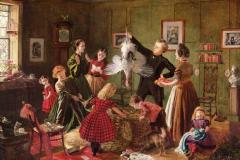 Image
Image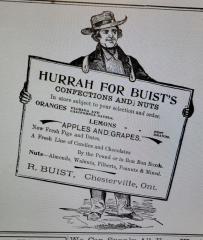
Lost and Found at the Dundas County Archives
ImageOne never knows what they might find in a box hidden away in an attic. It is as if one was on a pirate quest, and you have discovered a treasure chest. It is more likely, though, to find a box of unidentified photographs. So many such photographs have arrived here. While they provide a rare glimpse into a different time and place, and are much appreciated for that fact, it is also a chore to try to figure out ANYTHING about the subject in the picture. Without any form of identification, they are mysterious, anonymous and essentially lost to history. If we knew who they were, we would have so much more available to us to be able to research the story of the individuals pictured. They should help to tell a story about someone, to provide a memory of their life. Without this, they are just an image printed on paper.
First, I appeal to those who may read this, to PLEASE make some form of identification on the back of your photos. Ideally, this should be done in pencil so as not to damage the print. In a perfect world, one should then place the print delicately into an acid free folder for safety. While I may permit myself to be giddy with the delirium of potential, I will freely admit that we are in no way a perfect world. When a photograph is identified, they are in a sense immortalized. Their memory lives on. We know who they were, how they lived, who they were connected to. Without identification the are simply an image “unidentified and unknown”.
I am hoping that by posting some of these lost images that perhaps someone will recognize someone and let me know who they are. In a way, I am looking for people to claim identities in the photograph lost and found. It may not be the pot of gold but I would very much appreciate it if you would reach out to me at the Dundas County Archives if you can identify anyone in any of these photographs. Let’s give these people their due place in history. They once lived in Dundas County and had a family to love and share their lives with. Let’s get these people out of the lost and found! If you can identify anyone, even if only a suspicion, please email me at dundascountyarchives@gmail.com.Written by Susan Peters
Dundas County Archives
dundascountyarchives@gmail.com

